October and December 2019:
• Two miraculous discoveries of RODENT-PLANTED SEEDLINGS (from 2016 Medford OR seeds)
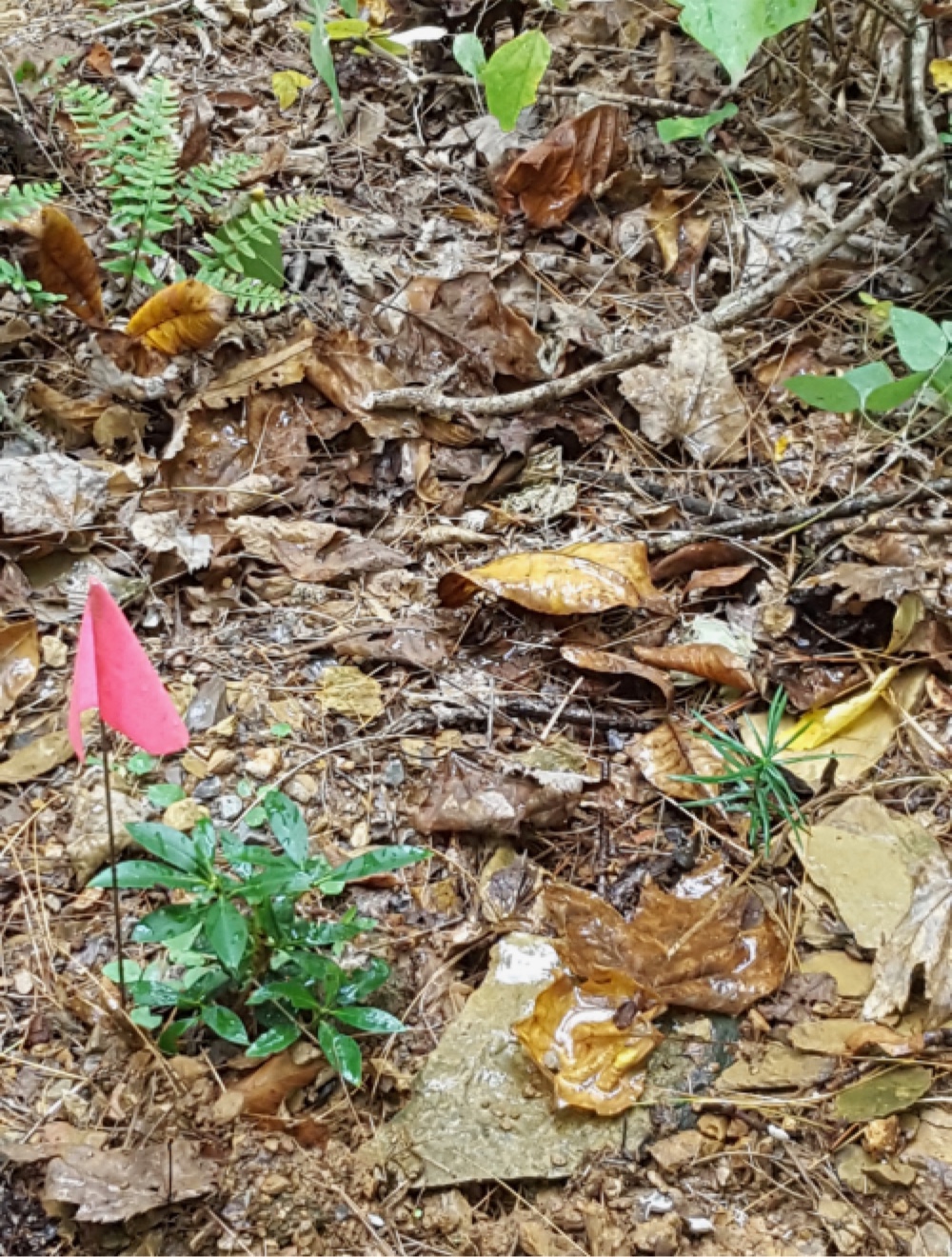 |
|
12 October 2019 email from Clint Bancroft to Connie Barlow:
PHOTO LEFT: "We have been in a very dry period, so I was carrying water to a dwarf mountain laurel (lower left in photo) that I had planted earlier this year. It is marked with the pink flag. This spot is about halfway down the driveway to the first cabin you come to from the main house.
Note with amazement (as I did) the seedling Torreya (lower right of photo). I did not plant it.
I have free-planted only a single seed and that was 3+ years ago down by the creek. It never sprouted. None of my other trees have produced seeds. The last seeds I have had are from Louisiana and they are in pots on a second-floor screened porch of the main house. So it is not one of those.
Unless a squirrel or other creature carried a Medford seed down there (something did get into the Medford pot by dislodging the wire-mesh cover and cleaned it out except for a single seed it missed and that germinated, still in the pot, earlier this year), I have no explanation for how it got there from the trailer/propagation area, which is a good distance away, if indeed that is what happened. We Orthodox love a good miracle. Could it be a sign?"
|
29 December 2019 email from Clint Bancroft to Connie Barlow:
Behold a SECOND strange and wondrous mystery (3 PHOTOS BELOW). A second miraculous germination without planting. You already know about the previous seedling (PHOTO ABOVE) that came up about 200 feet from the nearest seed source. This second one (PHOTOS BELOW) is about 12 feet from the first one. In the photograph that has a person standing in the background, the vertical stick in the ground is the location of this second miraculous germination and the other is where my friend is standing about 12 ft distant (by a pink flag). Both are easily 200 feet from my propagation area which is the only place seeds could have come from.
It's interesting that whatever rodent carried them down there placed them within close proximity to each other. I wonder how many more I will find scattered about? These have to be Medford seeds that were pillaged from their pot. And if they are indeed Medford seeds this means it has taken them three years to germinate. They both have come up in a not particularly good location, so I may relocate them The second one that I just found yesterday is actually right in the middle of the path that we had just climbed up. It's miraculous that we didn't trample it, since it was not very noticeable.
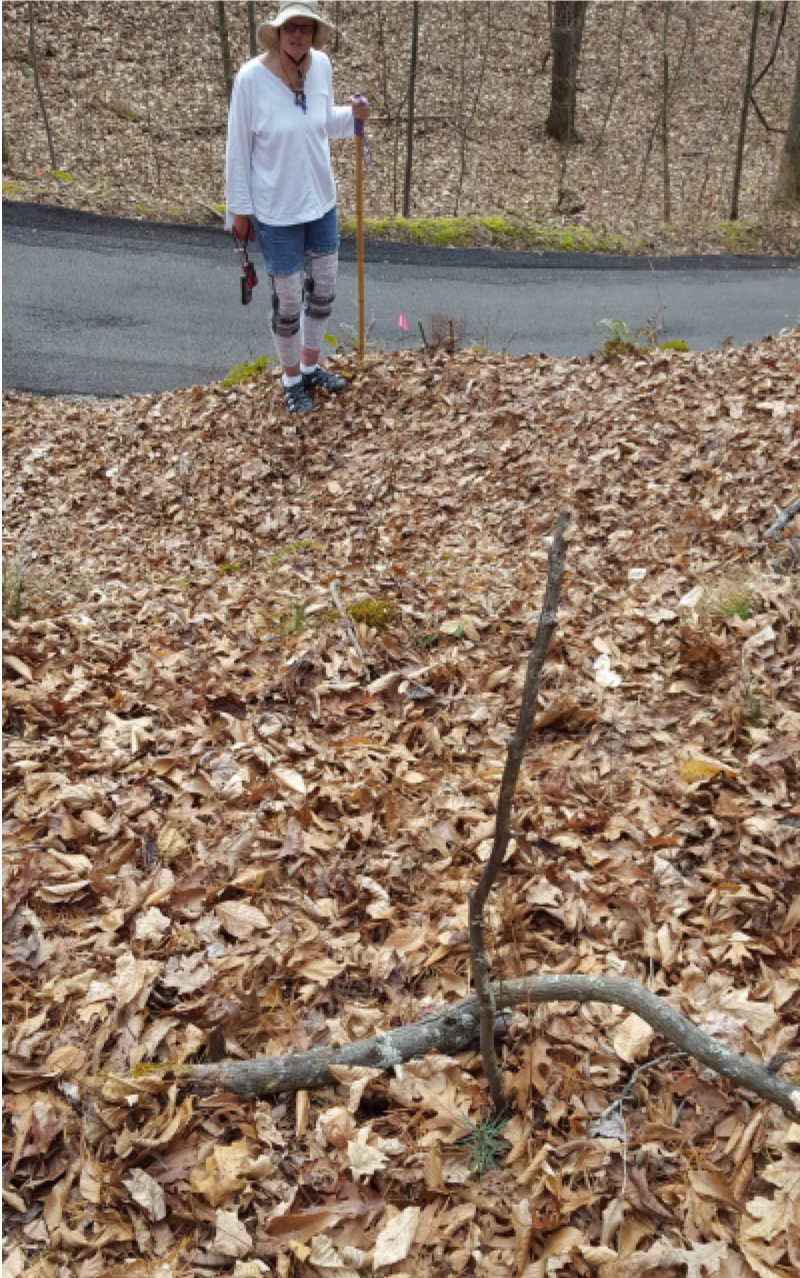
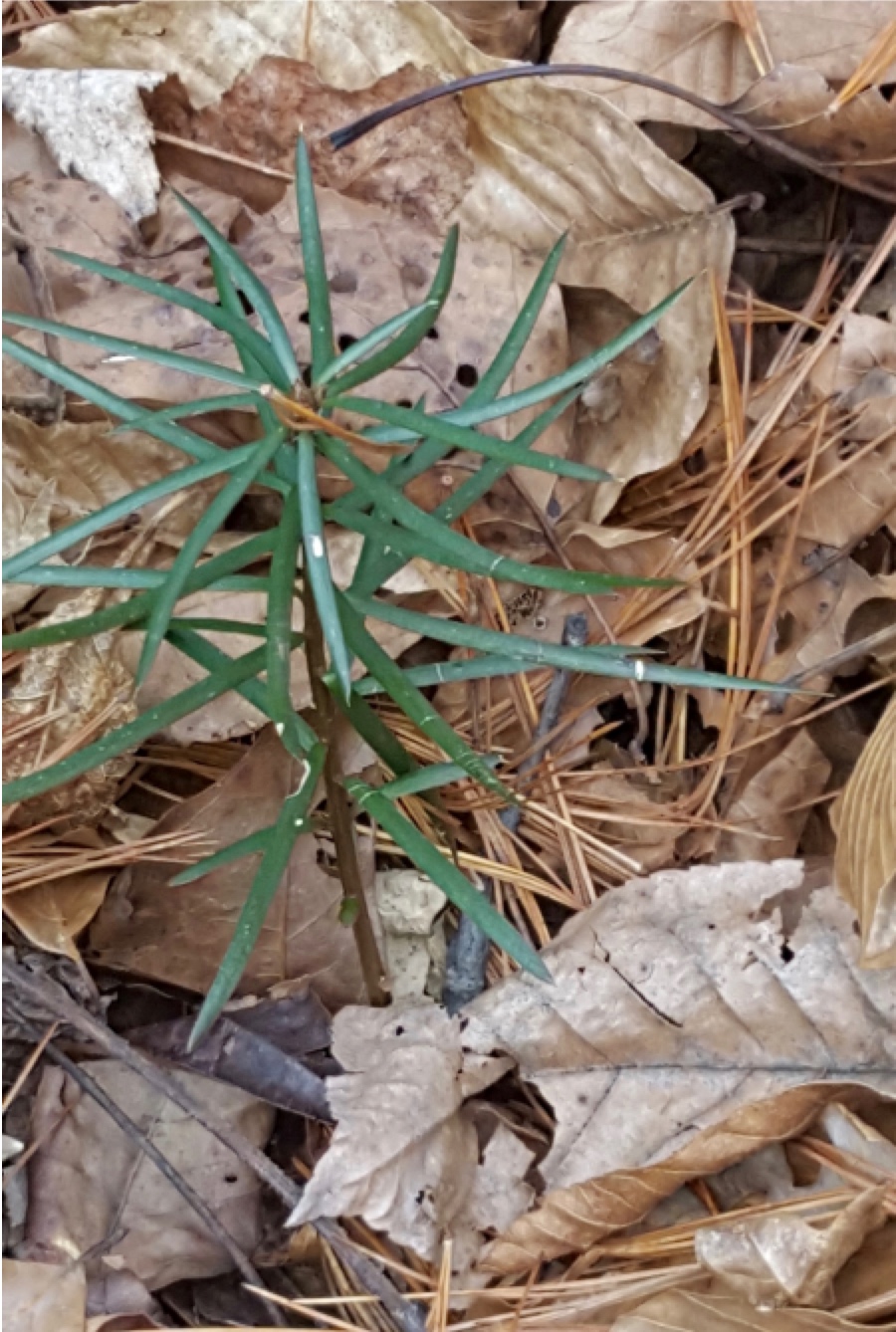
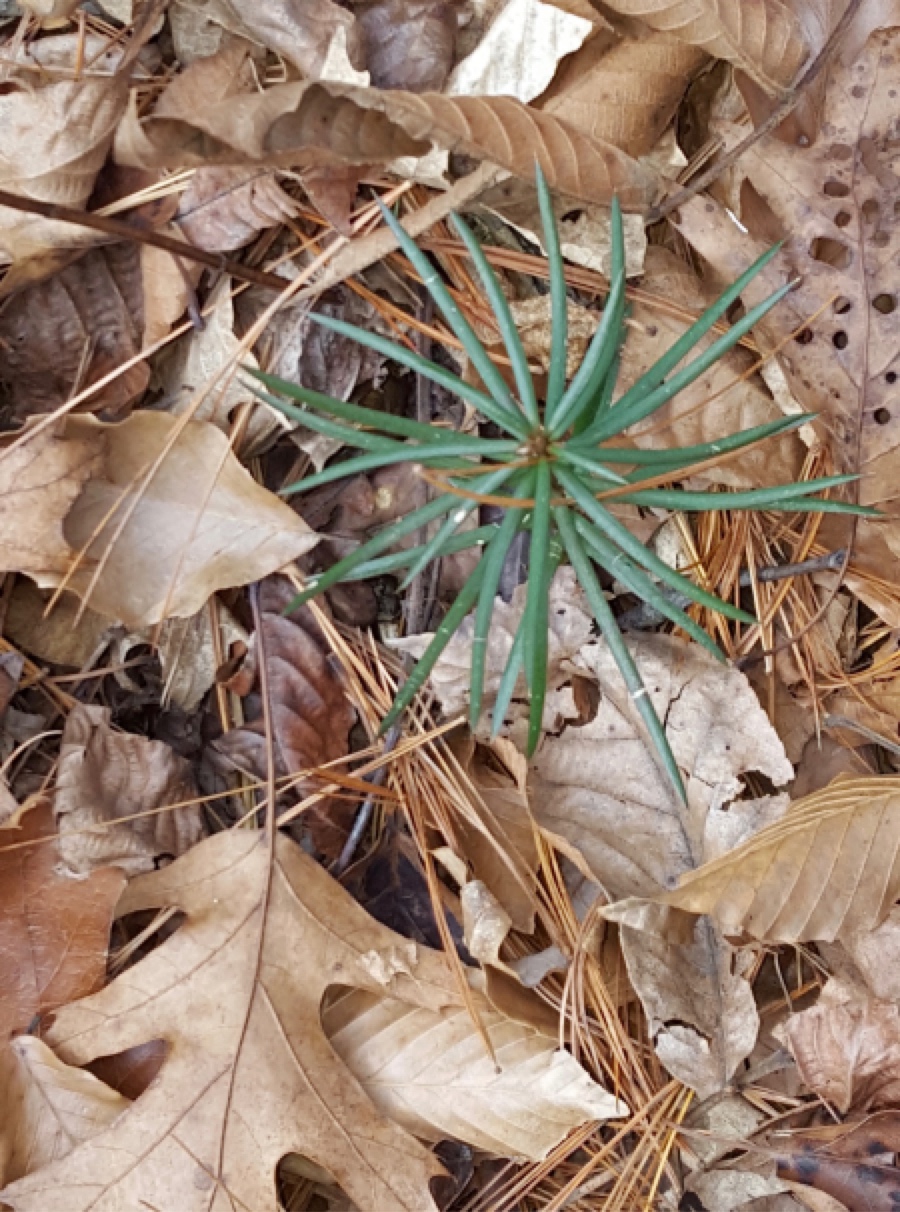
• March 2020 / Clint Bancroft / 2017 apical cutting of Highlands basal has developed superb roots
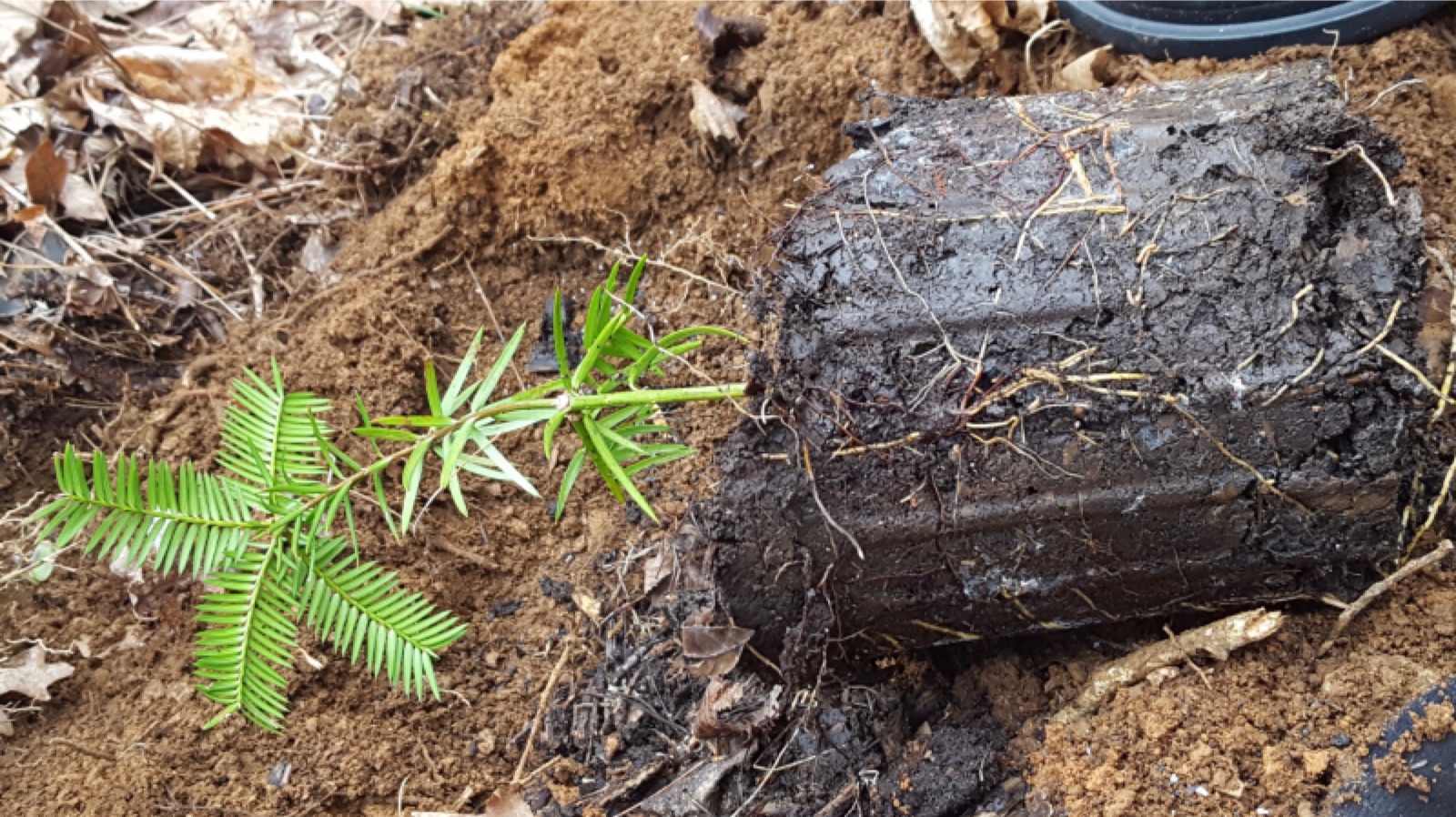
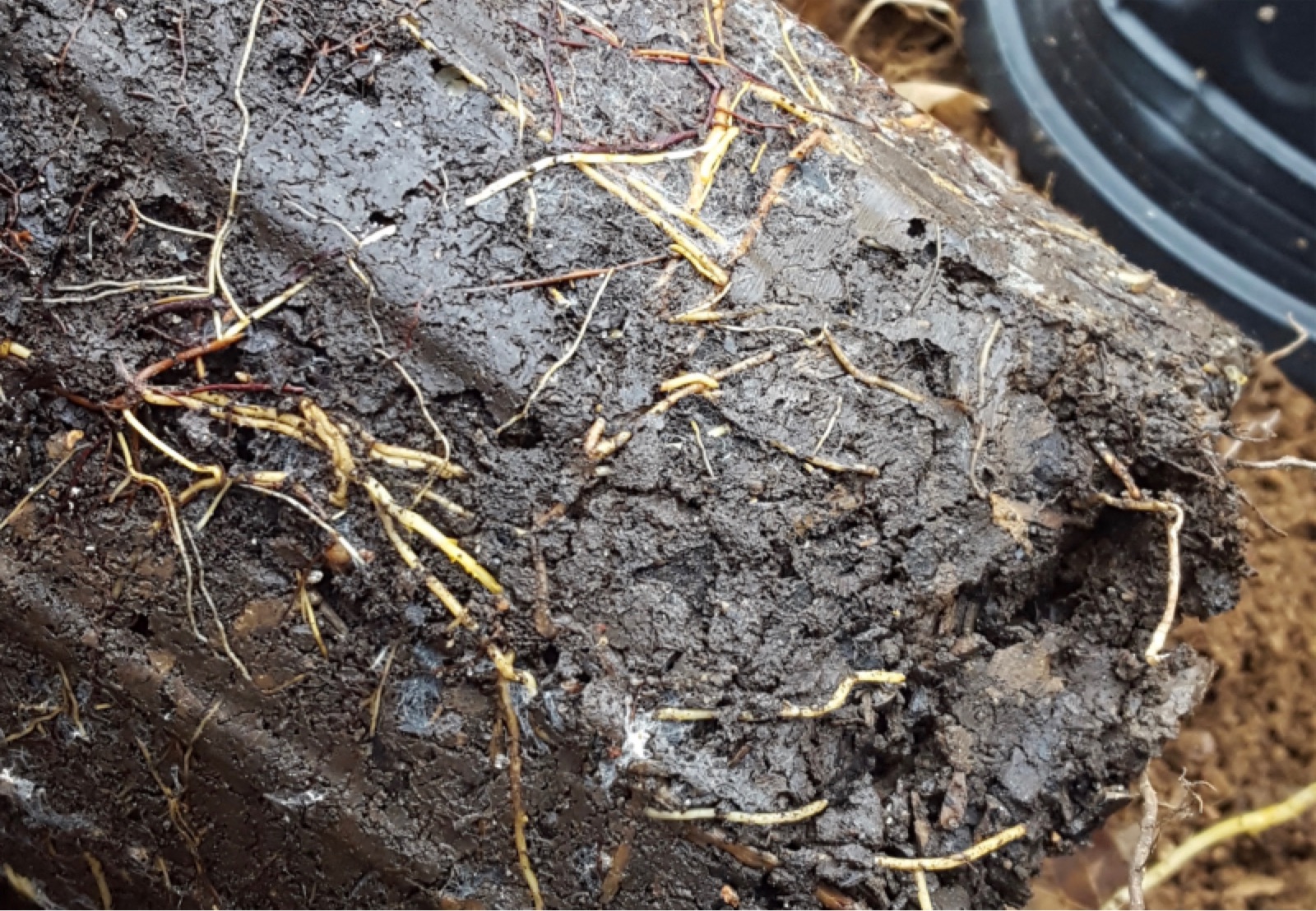 |
|
CLINT BANCROFT writes:
Here is the apical cutting [just removed from its pot] that put on four laterals last year. [Scroll up to the April 2019 entry to see the photo of this same rooted cutting with its four fresh little laterals.]
Look at the roots she developed! It currently has a central bud ready to go this spring, but no [second tier of] lateral buds at this time.
Although I was very pleasantly surprised by the root development, I don't know if this is typical or exceptional root formation since this is the first rooted cutting I have removed from its rooting pot.
This is the first cutting-grown Torreya to go into the Bowl. [The "Bowl" is a section of Clint's forest into which diverse genetics of Torreya are being planted with the goal of ultimately producing genetically diverse seeds. Clint's Torreya page has a "March 2019 Site Visit" illustrated section that documents his establishment of this "Torreya Bowl."]
I will be certain to label it as CUTTING GROWN so that we can learn if a cutting-grown apical will eventually form basal sprouts.
______
VISIT THE PROPAGATE WEBPAGE for details on the potting soil mixture in photo:
• Propagate Torreya
|
• March 2020 / Clint Bancroft / 2019 cuttings of basal stems from Clinton NC show fresh apical growth
Below are PHOTOS of 3 rooted apical cuttings of basal stems that were collected in Nov. 2019 at Clinton, NC. Some are from the horticulturally planted tall parent tree and others are from large progeny of the parent tree growing onsite. The photos show three examples of such cuttings clearly putting on new vertical growth. And some also show new radial lateral growth. All have been kept indoors in a bright, unheated room since their collection. I will move them outdoors under cages and maintain supplemental watering, as soon as we are past danger of a late freeze.
All the cuttings pictured are apical tip cuttings. I do have a few cuttings in the works that are non-tip lower sections of basal sprouts, but none of those have put on any new growth, vertical or lateral. I am not surprised. The tip cuttings all had buds ready to go, so it is not surprising that they took off. I think the non-tip sections of basals will put up verticals later, but are putting all their energy into establishing roots first.
Note: The stems may (probably) have benefited from having the lateral growth trimmed, but that was coincidental. The reason for the trimming was to make the cutting fit under the cloche!
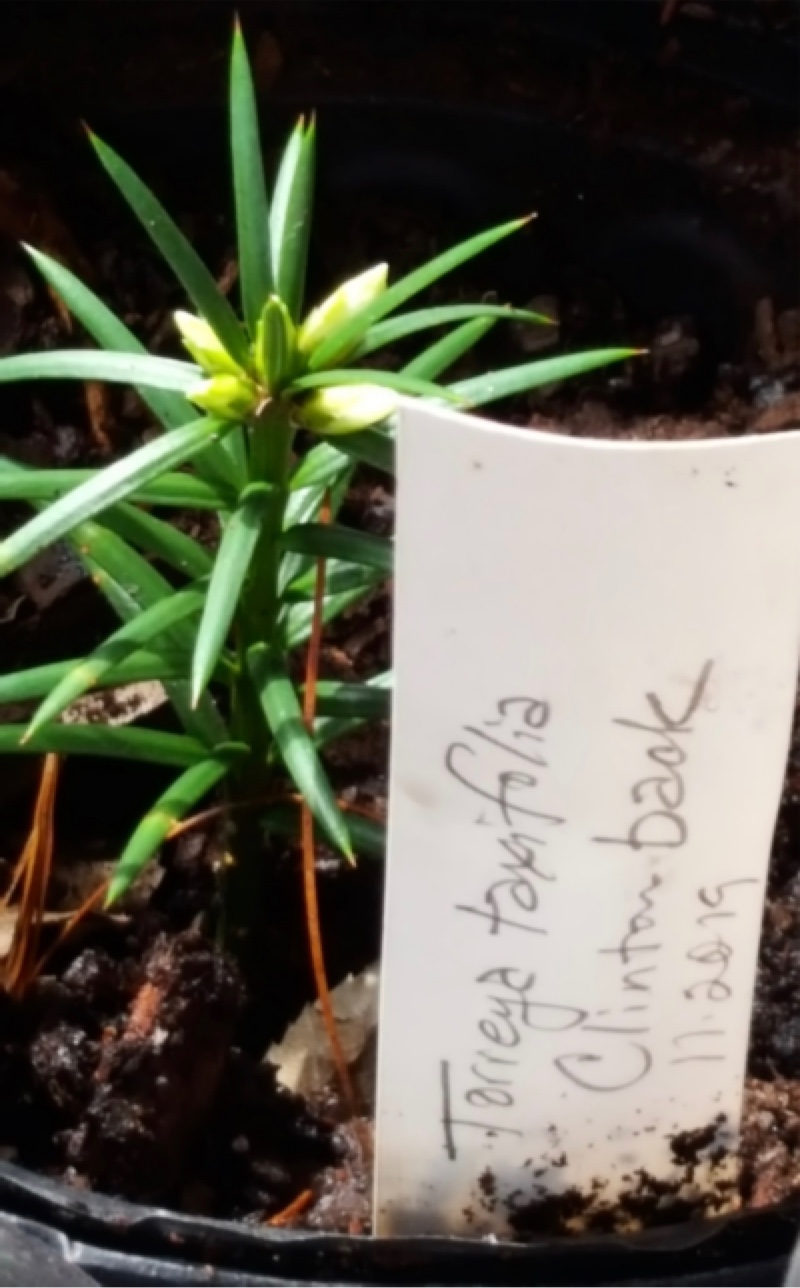
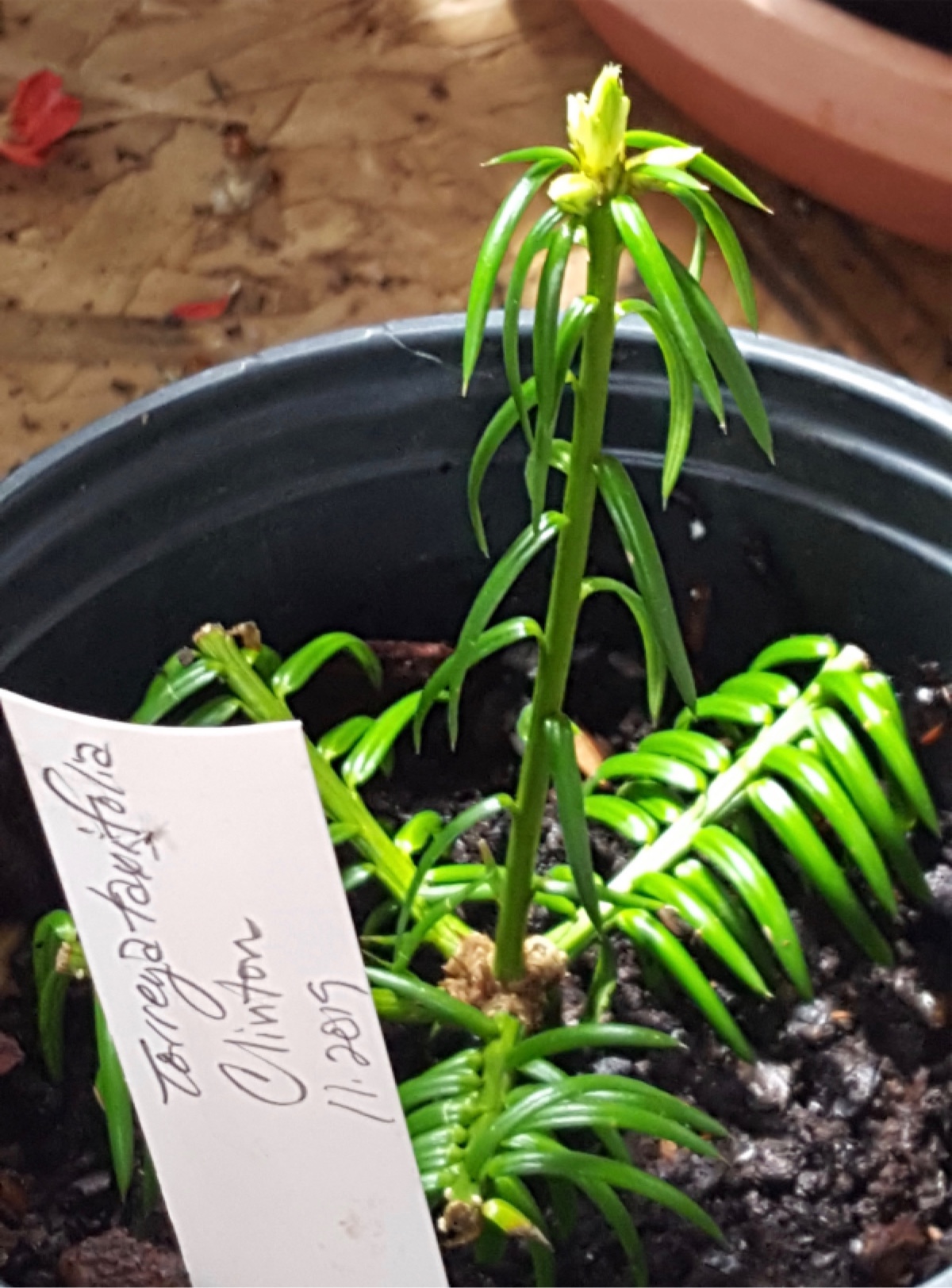
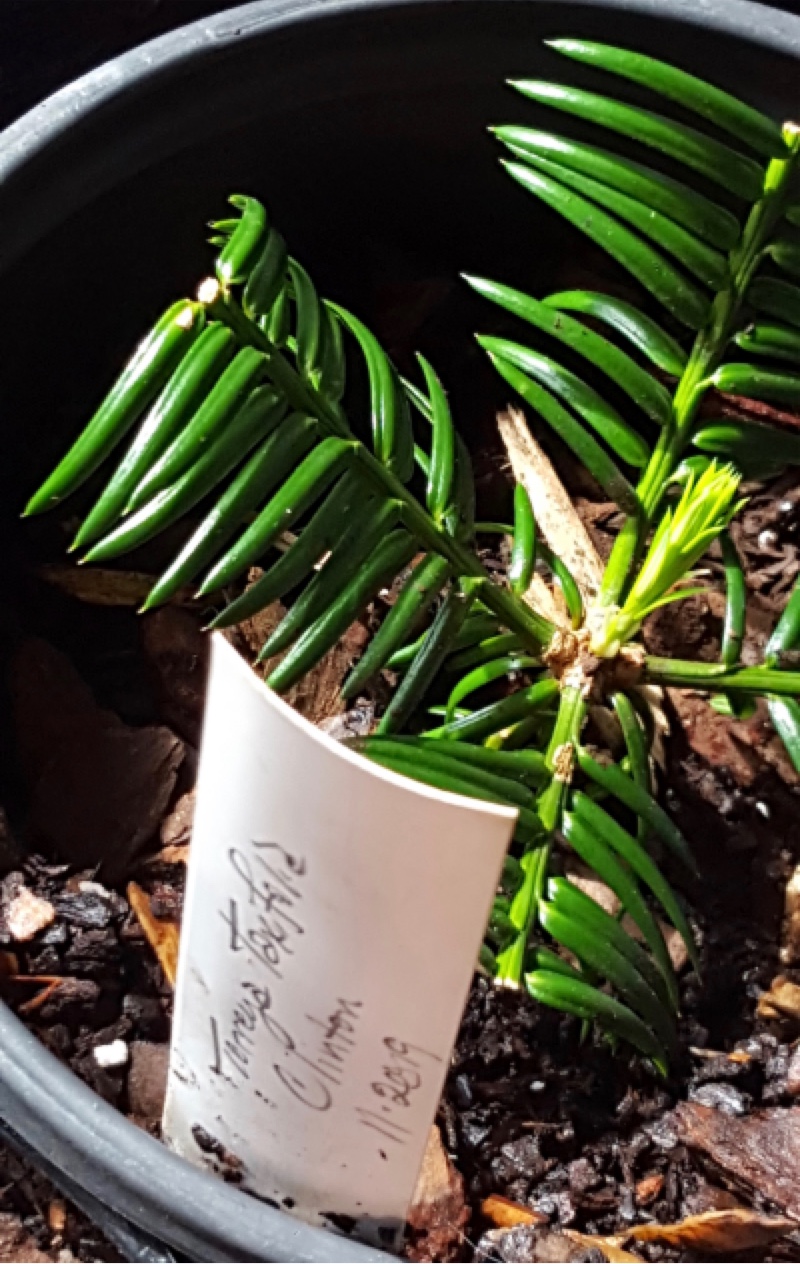
P.S. Here is an update on the Medford OR cuttings that Connie sent me October 2019: The Medford cuttings were kind of stressed looking when they arrived and I thought their prognosis was guarded. As with any group of freshly collected cuttings, some perished rather quickly. It appears some of the rest have rooted. I have not tugged on them. They still look as good as when they first arrived. But that alone is not proof of root formation. I have had cuttings that still looked fresh after a couple of years under the cloche but which never rooted. They just keep their color for a long time. That explains why Mrs. Kennedy (Clinton, NC) prizes them for Christmas decor!
• June 2020 / Clint Bancroft / Apical basal stem cuttings from Highlands NC prove tree-form success
Below are photos of 7 successfully rooted apical cuttings of basal stems from the mature grove of seed-producing Florida Torreya trees near Highlands, NC. Clint Bancroft collected apical cuttings from some of the mature tree basals in October 2017. Clint writes of how he protected these cuttings from herbivory: "They were rooted indoors in an unheated room and have never been outside my house. They are currently on a second-floor screened porch, which has no access except from inside the house. I will move them outdoors later this year but they will be in wire cages as secure as can be." In these photos you can see that "they are as I collected them, except they have put on new vertical growth this spring." SIGNIFICANCE: This set of photos offers very strong additional evidence that using apical cuttings from basal stems (rather than cuttings from lateral branches) will assuredly result in tree form growth (rather than everlasting shrubs).
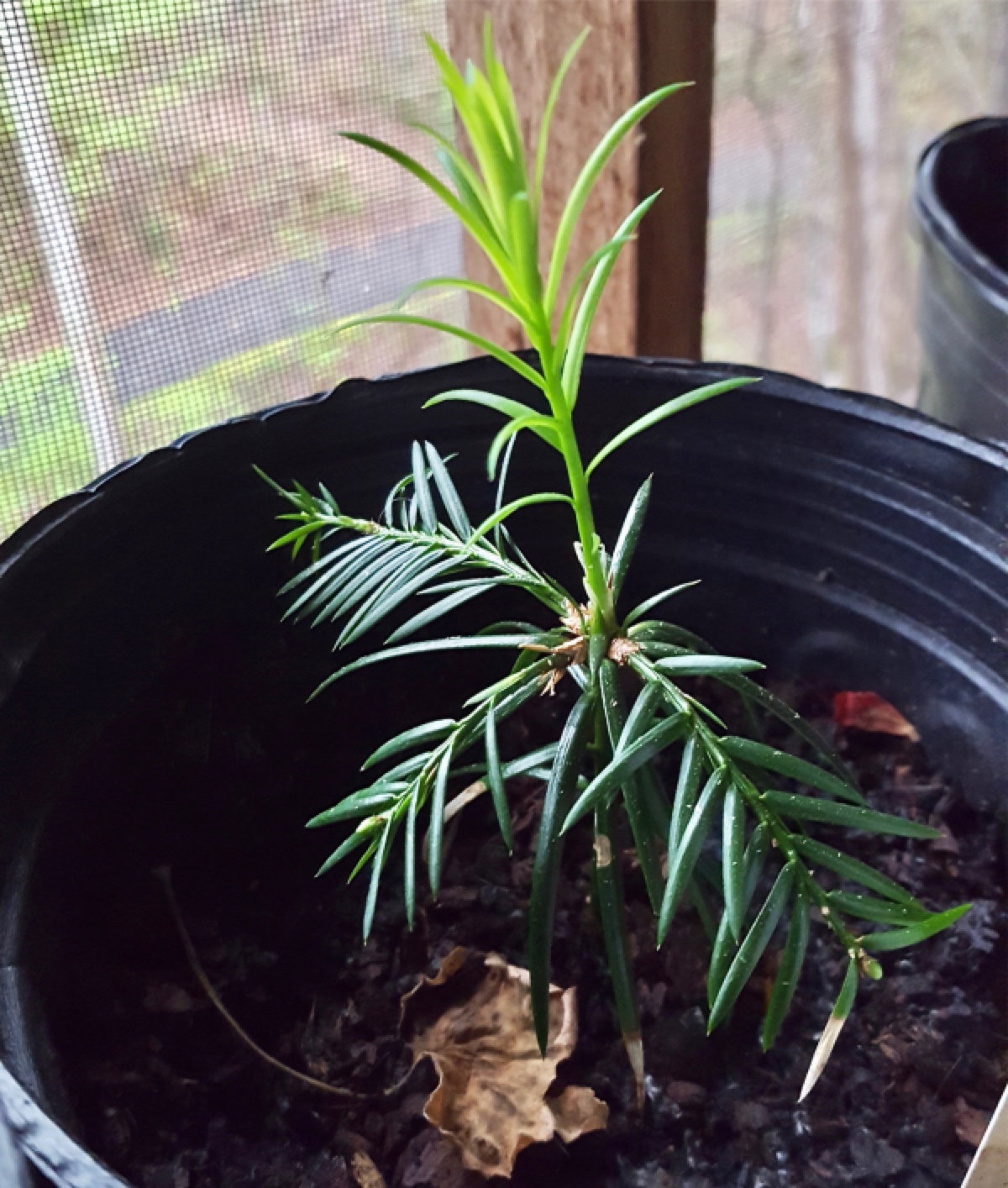
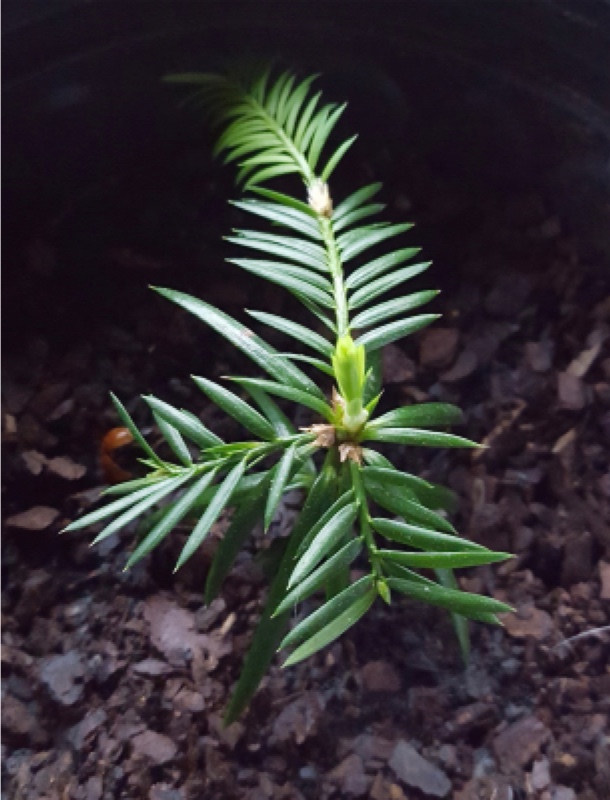
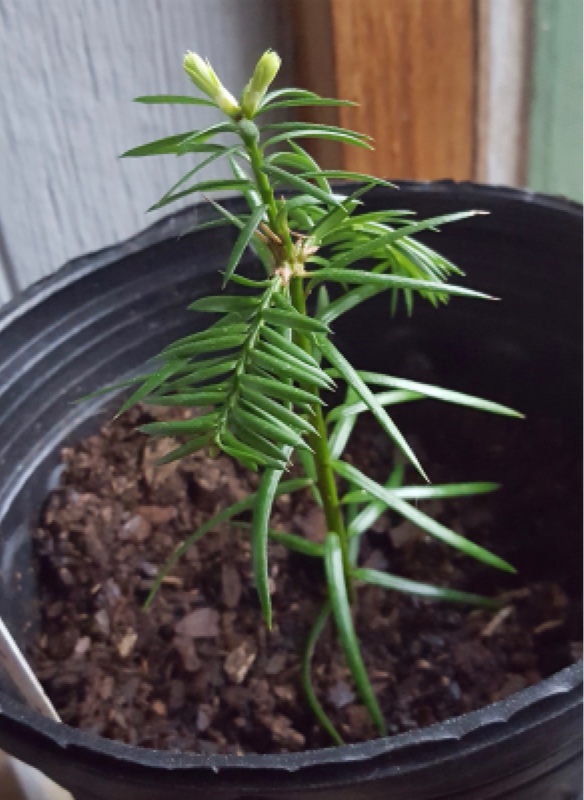
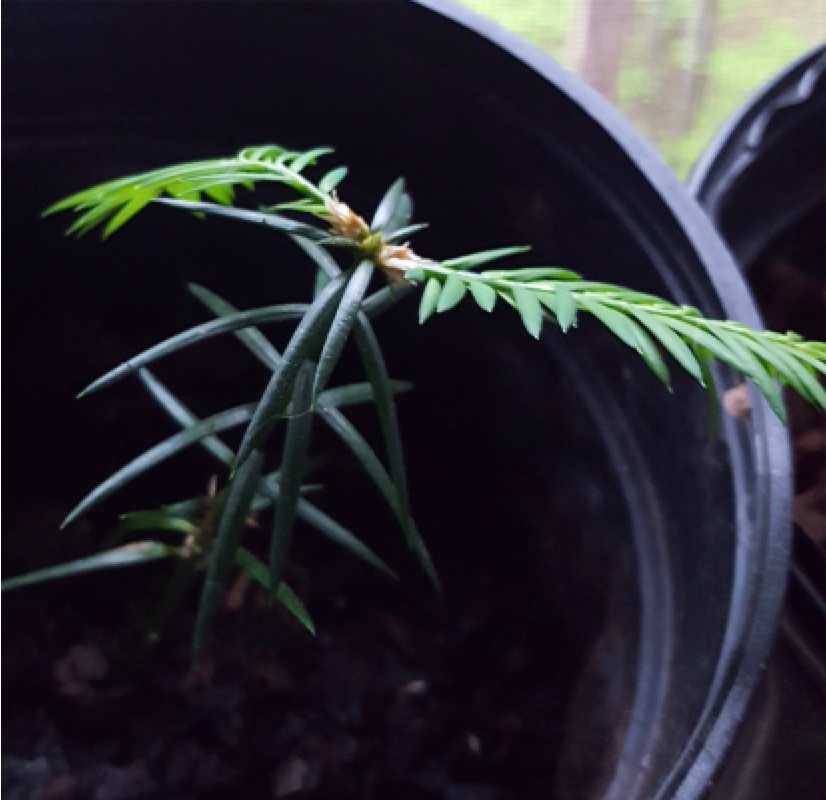
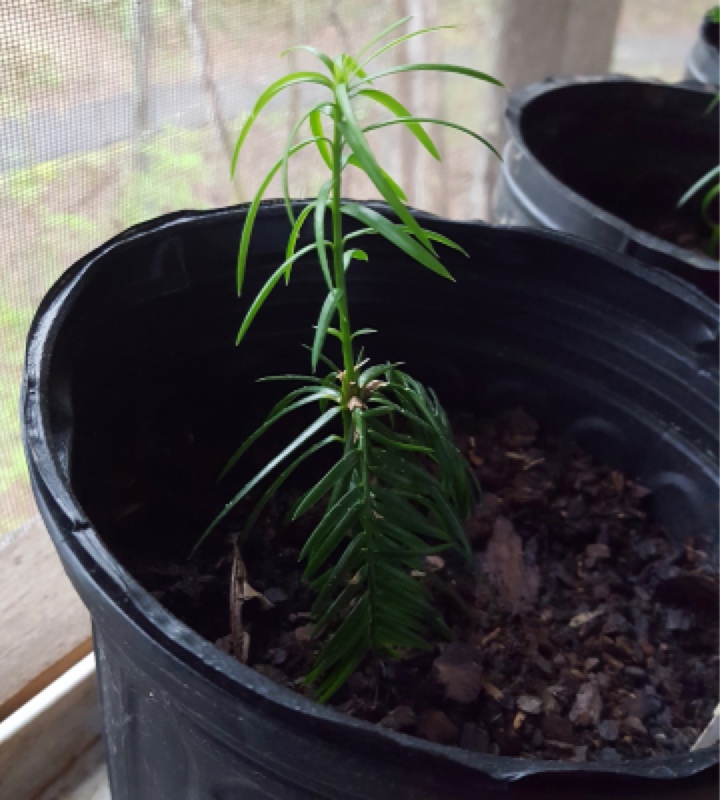
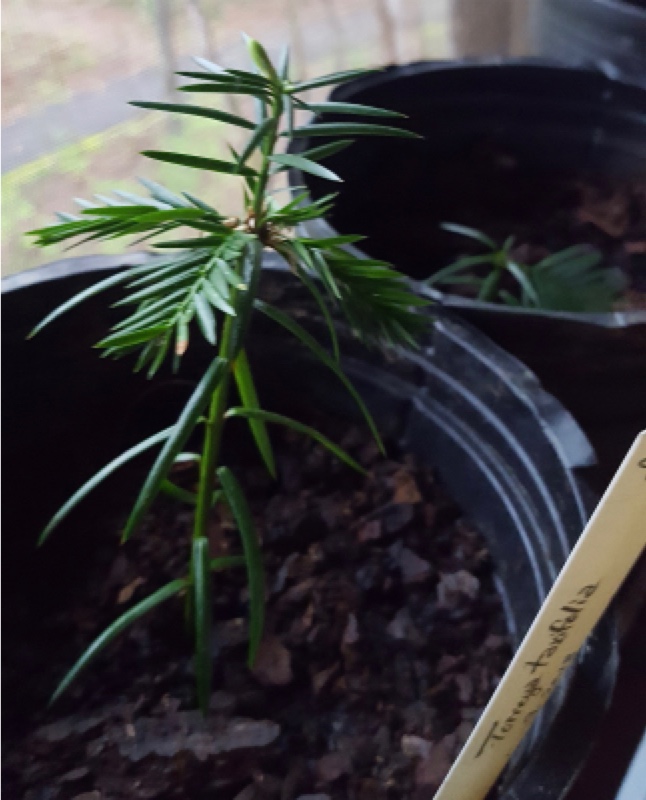
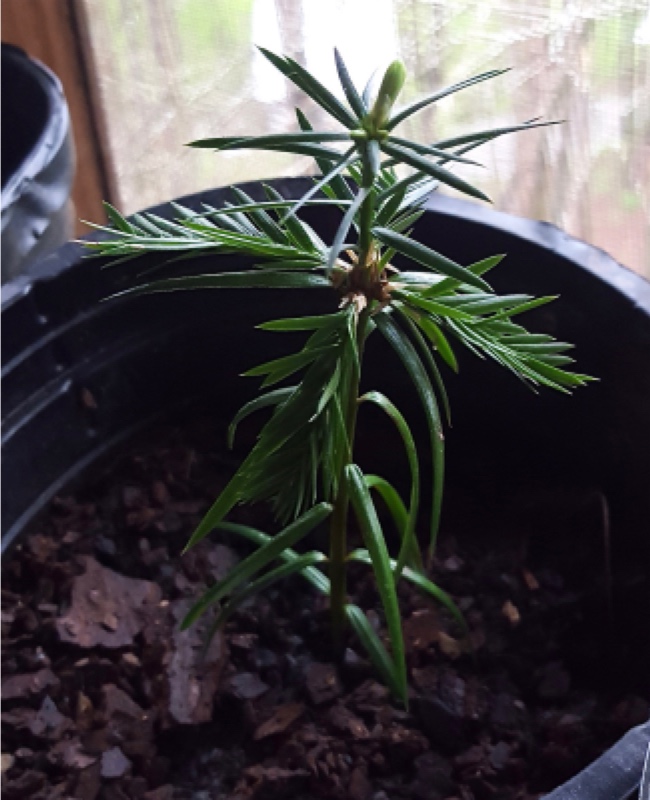
• July 2020 / Clint Bancroft / A 2018 seed from mature Torreya grove in north Louisiana germinates!
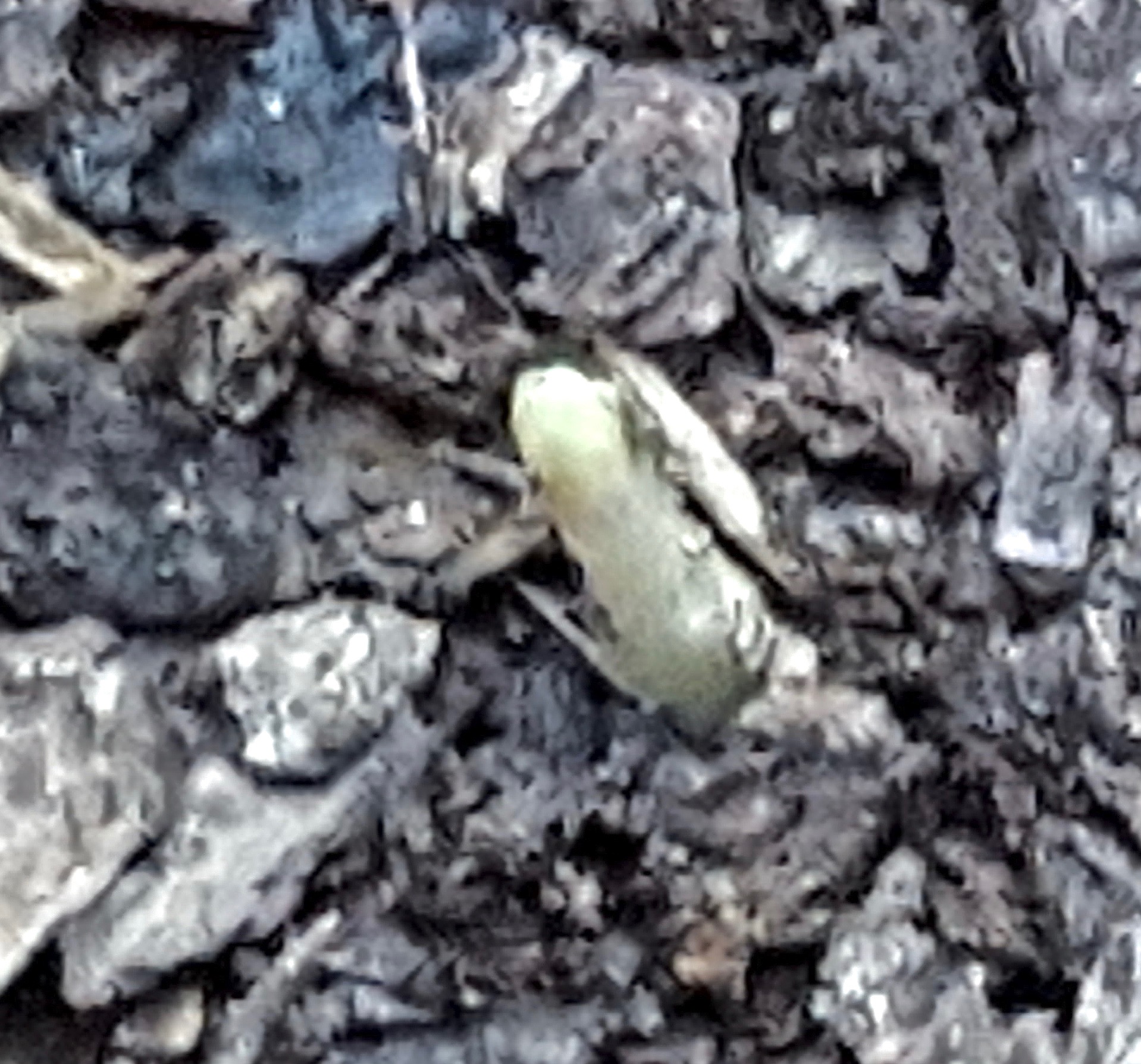
|
|
Clint participated in the November 2018 site visit to Briarwood Preserve in northern Louisiana. The preserve donated 3 seeds to Torreya Guardians, which Clint volunteered to germinate and foster.
Photo left is the first germination.
Experience suggests that this nearly 2 years for germination is fairly typical for this large-seeded endangered tree.
As usual, Clint provides very secure protection against rodents, which are both avid seed predators and occasional browsers of new growth.
|
• July 2020 / Clint Bancroft / Severely stressed transplant from November 2019 site visit to Clinton NC recovers!
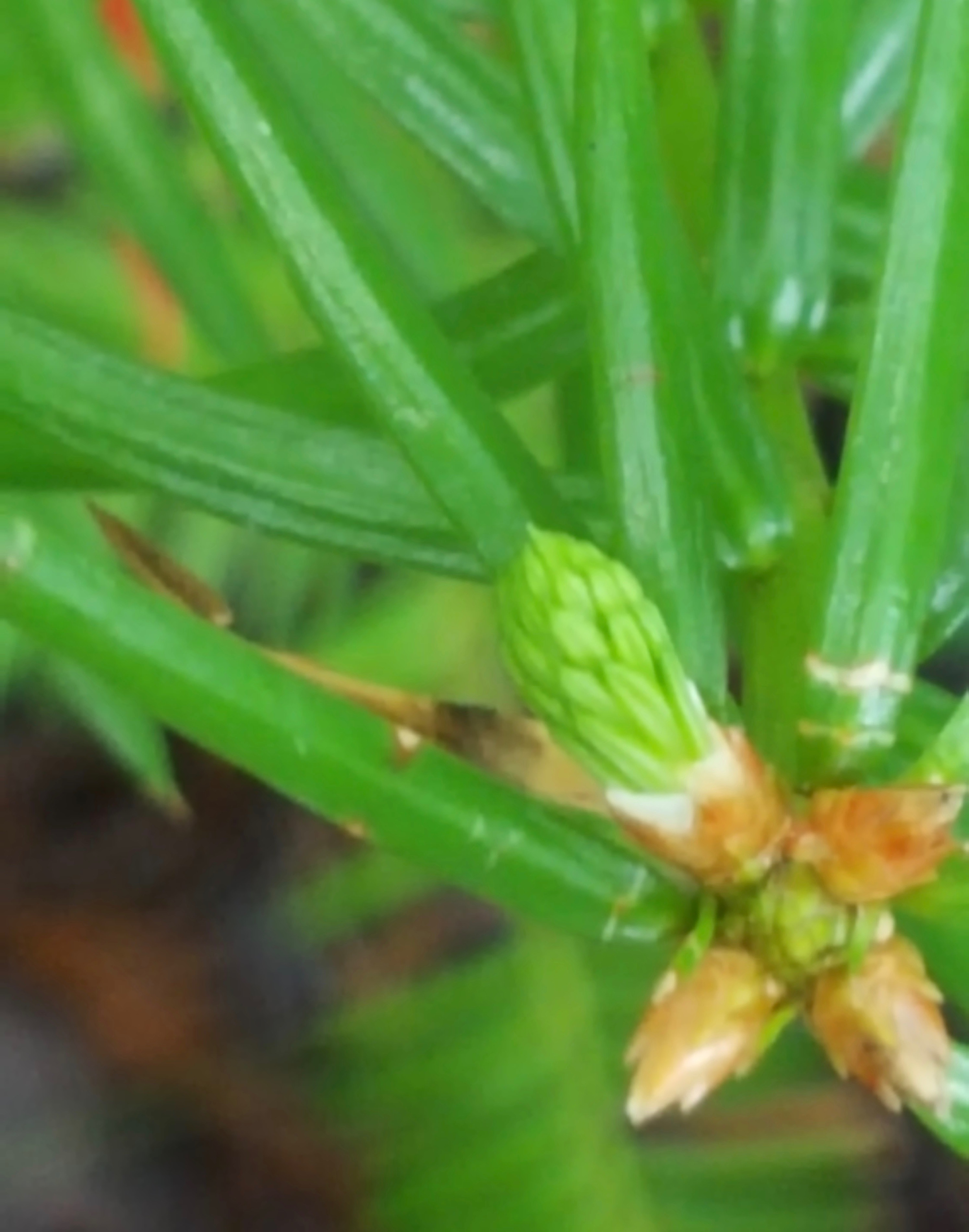 |
|
Here is a close-up of a portion of the larger Torreya I had dug from under the evergreen domestic camellia at Mrs. Kennedy's in Clinton, NC (during site visit of November 2019; see Clinton torreya webpage).
I guesstimated the tree to be about 8 years old. The taproot took a severe beating from its extraction, and there was no soil left on any of its roots.
After looking very stressed since I got it into intensive care, and after its losing several small branches since collection, it appears to finally be exercising its option to live. I suppose it sacrificed some small branches to help it muster the energy to recover from its trauma.
EVIDENCE OF RECOVERY: It had apical and lateral buds when collected, but they shrank, got brownish, and did not burst this spring. Just a few days ago one of the laterals has come to life (photo left).
It looks like this tough Torreya is going to make it. I will not even entertain the notion of outplanting it until fall of 2021. |
• March 2021 / Clint Bancroft / First seedling appears from Fall 2019 Mt. Olive seed harvest; it comes from a seed that was a floater.
"I kept one pot of Mt. Olive 2019 Torreya seeds on the upstairs screened porch last year and earlier this year brought the pot into a cool room inside the house. Today I noticed a sprout, already about 4 inches tall. None of the pots that were kept outdoors the whole time have shown any sprouts yet.
... The reason I had kept that particular pot of seeds in the house, while the rest went outdoors, was to keep a closer watch on its potential activity: the tag on the pot indicates that these seeds were all FLOATERS! You might want to share this, particularly with Joe Facendola, since we have sort of come to think of FLOATERS as duds. That is just not true!! The informal study I did several years ago with FLOATERS vs SINKERS showed better germination percentage of FLOATERS. Percentage germination between the two groups was similar (I did not make a formal count), but the FLOATERS excelled slightly. Bottom line is, don't discard FLOATERS.
EDITOR'S NOTE: I just did an internal google search on our Torreya Guardians website for the word "floater" and found on our 2009 seeds webpage a note from LEE BARNES stating,
"Several folks have commented on the need to not let seeds dry out prior to cleaning and stratification. I am concerned that seeds that 'float' may have lower germination due to drying or less stored food, etc. But Dr. Croom noted that he had heard of good germination of 'floater' seeds (personal communications with Maclay Gardens in Tallahasse FL, who indicated 80% germination from floaters). Others suggested soaking seeds for 24 hours after cleaning. I retested my initial 'floaters' that had been stored for several weeks in moist sphagnum moss and found that most were now 'sinkers.' I did have one uncleaned seed that had rolled behind a container and dried for two weeks that audibly 'rattled' inside the woody seed coat. I tried resoaking the seed but it remained a 'floater' after several days of soaking. This suggests to me that as little as two weeks seeds can dry out a seed, so I suggest that all seeds be stored in moist sphagnum immediately upon collection and prior to removing fleshy tissues by cleaning. I am curious if the floating seeds might have aided distribution of a species now primarily found growing along a major river?" [This same contribution by Lee Barnes also appears on our PROPAGATION webpage.]
As well, Lee contributed a short report on 11 January 2010 of results of 301 seeds donated to us by Biltmore in Fall 2010. He reported 115 were floaters and 186 were sinkers. Also, "We received notice that of the autumn 2009 seed crop from the Biltmore that we distributed, 4 of the seeds distributed to an arboretum in Switzerland germinated in the spring of 2011. Among those, 3 had been floaters and 1 was a sinker."
BUFORD PRUITT, our torreya planter in Brevard NC, also found success with floaters. He reported:
"... Those cages also contain 15 seedlings from the 2012 crop of 20 seeds given to me. The 2012 seeds were small, pale floaters — quite unlike the larger, darker, denser 2010 and 2011 seeds. I planted 4 to a 1-gal pot (previous years had 2 per pot) in Florida. By late April, 4 of them had sprouted and were growing vigorously. Shortly after moving from Florida to North Carolina, a flush of 8 sprouted during early June 2013 and another 3 have sprouted since then. That totals 15 sprouted seedlings from the 2012 seeds, or 75% success rate thus far."
• November 2020 + 2021 / Clint receives seeds from Clinton and Mt Olive NC horticultural seed harvests
From 2020 harvest, Clint was sent 170 Clinton and 70 Mt Olive seeds.
From 2021 harvest, Clint was sent 200 Mt Olive seeds.
• February and March 2022 / Clint Bancroft / Update on Florida Yews
I have more than a few Florida Yews. In fact, I planted two new ones down near the creek today. At one time I had around 30 but have lost a few to God knows what. Sudden orange death I call it.... The yews that died were on moderate to steep slopes. The ones at "creekside" are away from the creek and on either a slope or atop a mound.
• April 2022 / Clint Bancroft / Voles have killed several out-planted potted seedlings
Jack stopped by briefly a few weeks ago and we surveyed the "Torreya Bowl" [a backwoods location where Clint is planting maximal genetic diversity near one another]. I wanted to show him how one of my precious Medford seedlings (one of only 5) had died. We also found that a 5 (or so) year-old seed-grown Blairsville tree was also dead. Jack tugged on the dead Blairsville tree and it came right up, having no roots left and the bark having been chewed off from the ground upward about 7 inches. Thinking about changing the name to the Vole Bowl!! I was sick over the Medford tree. None of the Medford trees have grown quickly compared to trees from some other sources. It has been interesting/puzzling why trees from one source seem to consistently outgrow trees from another source. The trees from Mail Order Natives clearly outgrow all others, with Blairsville being a close second. My biggest tree is, not coincidentally, a Mail Order Natives tree which was purchased as a gift for me by a friend from Native Nurseries in Tallahassee. It is now about my height; short for a man but not bad for a Torreya!! Trees from other sources survive but do not exhibit the same growth rate.
I should have germination of Highlands and Clinton seeds this summer.
Note on FLORIDA YEW: I have not had any great problem with my FL Yews. In fact, they seem happy. I have lost 2 (out of about 30) and there was no clear cause for their demise. I did have one to be eaten almost to the ground by I don't know what. The tree was caged and is close to numerous other specimens also in cages. None of the others have been touched. The eaten tree is regrowing.
• June 2022/ Clint Bancroft / Precious Norlina NC cutting of a basal tip has rooted!
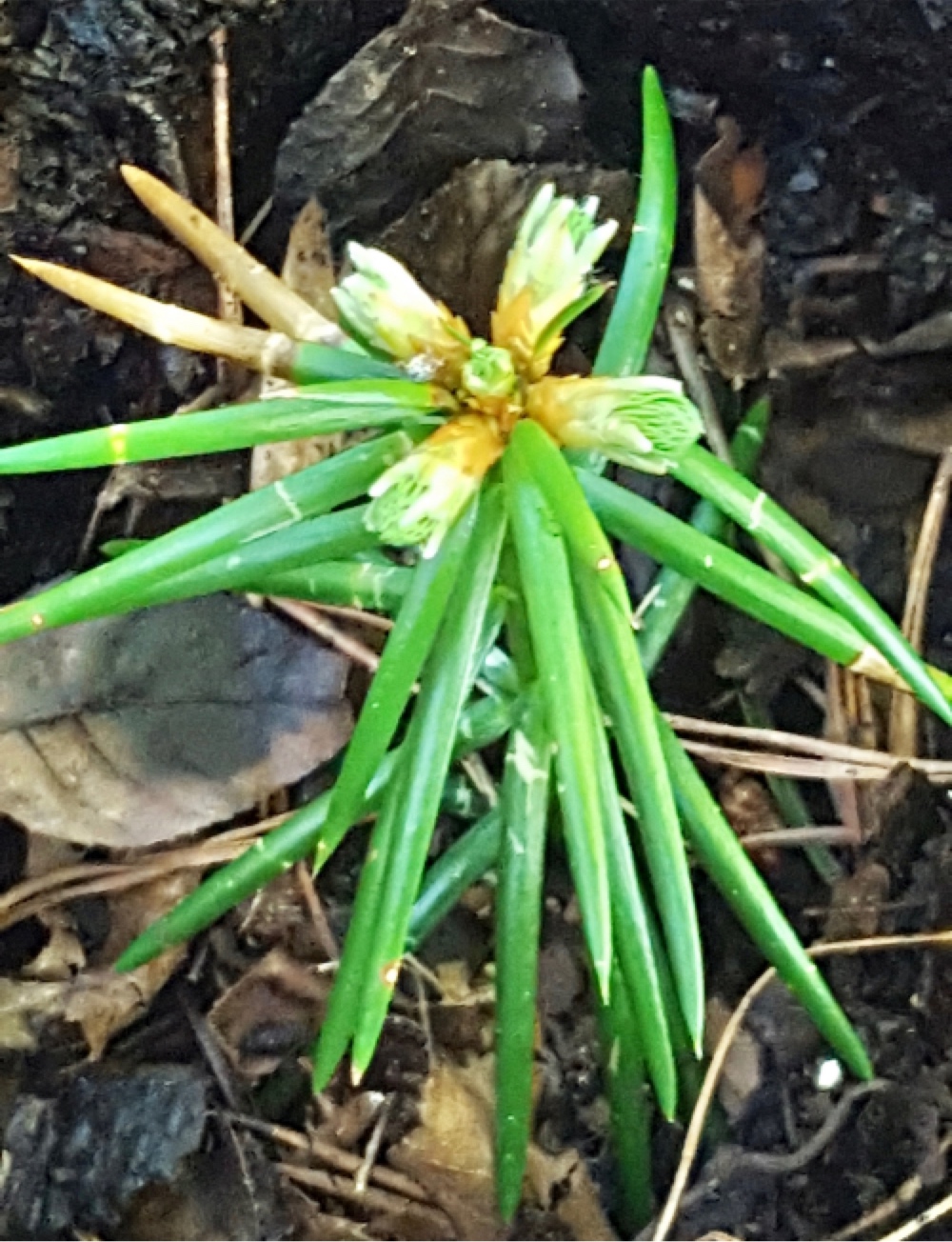 |
|
BACKGROUND: December 2021, PAUL CAMIRE photo-documented the NORLINA TREE in North Carolina and took some basal sprout cuttings.
PHOTO LEFT: May 10, 2022, CLINT BANCROFT sent this photo and reported that it had "rooted" (and thus was on its way to becoming a tree). Clint wrote:
"I know it is rooted because I tugged on it GENTLY and got resistance. I would not have tried that this early on except, to my delight, it had put on apical and lateral growth.
"The tiny five buds were present when I received the cutting from Paul, but I really did not expect to see them burst, especially during their first spring.
"This appears to be the only cutting which is apical. However, they have ALL rooted (by tug test) and most have new growth."
SIGNIFICANCE: Visit the OFFSPRING section of the main Norlina Tree page, and you will grasp the significance of establishing a 100% clone of this 160-year-old tree, whose descendants now inhabit many states.
|
• July 2022/ Clint Bancroft / Visits torreya seedling he donated to Reflection Riding Arboretum & Nature Center, Chattanooga TN
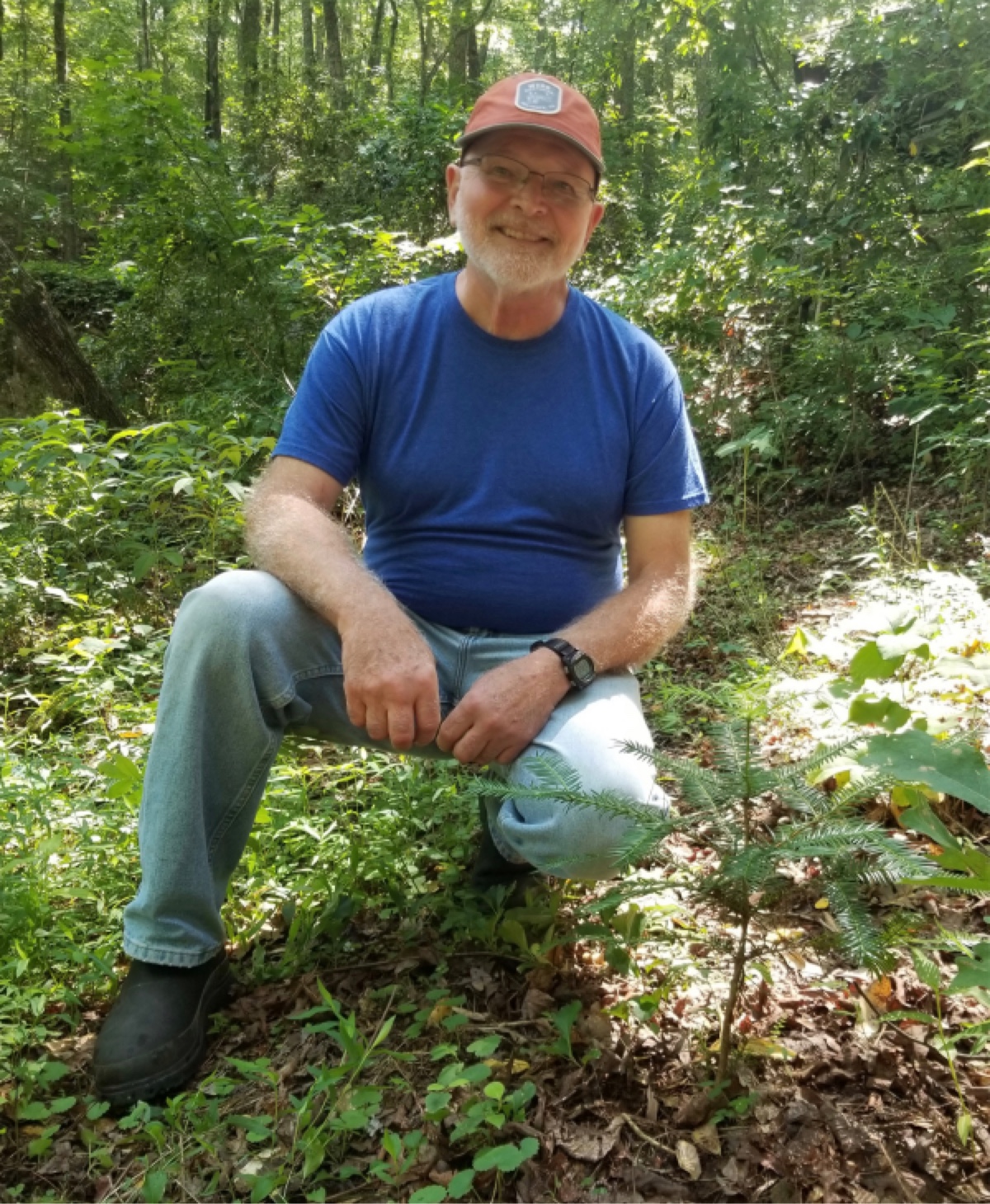 |
|
CLINT WRITES: "I went to Reflection Riding Arboretum in Chattanooga today and was able to get someone to show me where they planted the Torreyas I gave them 2 years ago.
There were 6 trees donated, and they already had one which was still in a one-gallon pot.
They were only able to locate two of them today, but promise they will locate the remaining trees.
Both the ones I got to see looked sweetly content. One had a new vertical and also had 2 basal sprouts which were not there when I donated the trees. The second had 4 new lateral branches with no vertical growth so far."
PHOTO of Clint alongside one of the picture-perfect torreys at the arboretum.
_____
Reflection Riding Arboretum & Nature Center is near downtown Chattanooga, TN. It is a nonprofit arboretum, botanical garden, nature center, and historical site located at 400 Garden Road, Chattanooga, Tennessee. The facility includes the 317-acre arboretum, 15 miles of trails, live animals indoor and outdoors, and a treehouse.
|
• September 2022/ Clint Bancroft / Proof that a basal sprout will form on the rooted cutting of the apical tip of a basal stem cut from another torreya
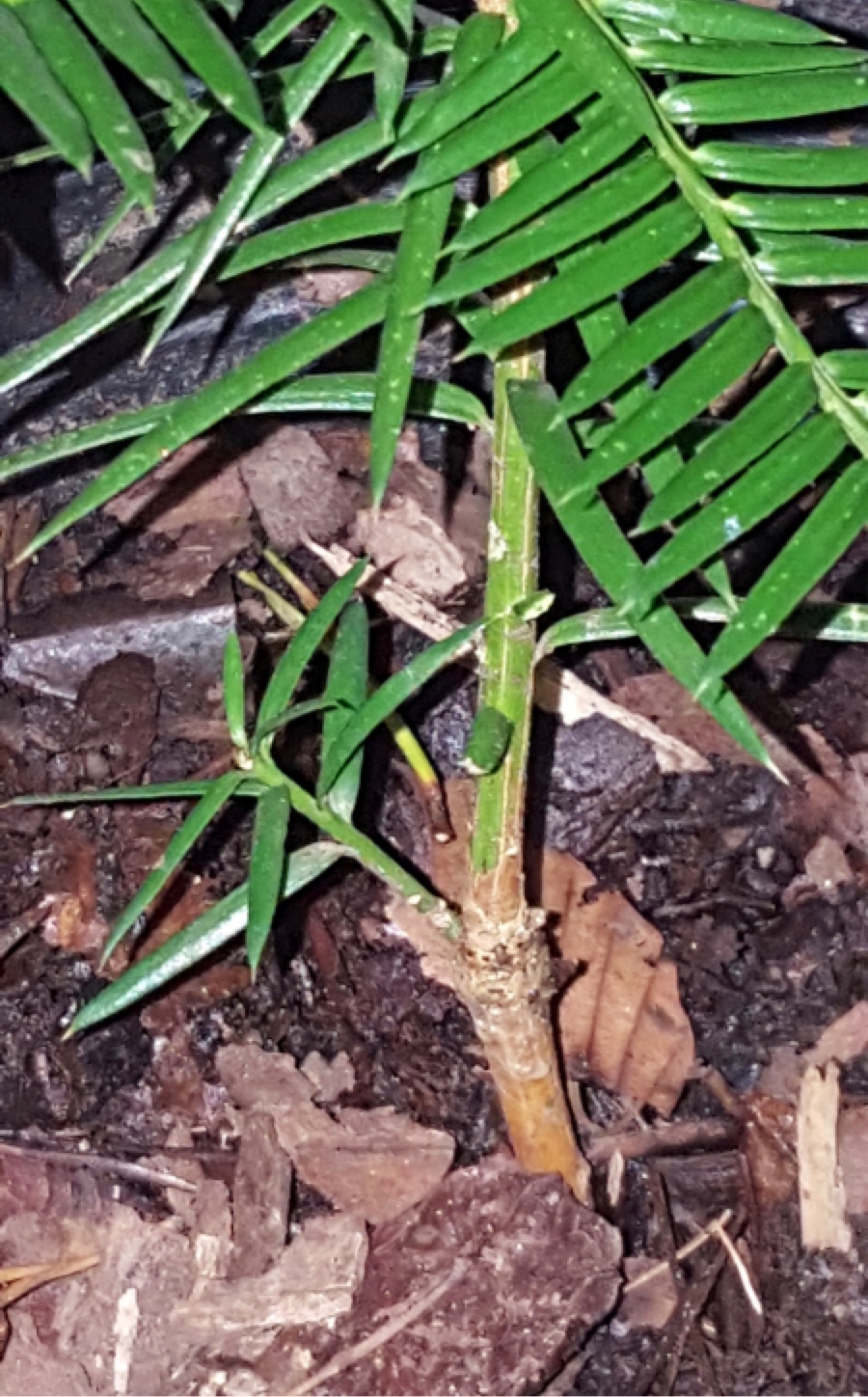 |
|
Email to Connie Barlow 2 September 2022:
"We have wondered if a rooted apical basal sprout will eventually form its own basal sprouts. This PHOTO shows a basal sprout which has formed on a rooted apical cutting from one the Highlands, NC trees. My tag says it is from a cutting I took there in October 2017."
LEARNING: Finally, we have confirmation that not only will a rooted cutting of the apical tip of a basal stem grow into a tree-like (rather than shrubby) form. Now we know that it will also grow basals of its own! This assures us that, as with its wild cousin California Torreya, Florida Torreya grown from apical basal cuttings will indeed be capable of manifesting the tree form again and again — no matter what injury may kill the main stem itself. Nobody has tried to guess whether the rootstock itself may endure for perhaps millennia because annual growth rings do not form below the soil. (Even the well-studied Coast Redwood has not had this mystery answered.)
|
• November 2022/ Clint Bancroft / EXPERIMENT: Can a vertical branchlet cutting from an old rooted lateral produce a tree form?
An acquaintance in Pensacola FL has a cutting-grown Torreya from Semmes, Alabama (Dodd and Dodd nursery). Last year (2021) his plant, which is a sprawling branch still less than 3 ft long and growing parallel to the ground, put on several vertical sprouts from the trunk (stem). He allowed me to collect most of those sprouts — and they have rooted. So far, it appears one may make a tree form and the others are iffy. When I'm back in Pensacola I will ask him if I can photograph his plant since I left one or two of the verticals on it to see what they will do.
PHOTOS (Nov 2022) of four of the rooted cuttings:
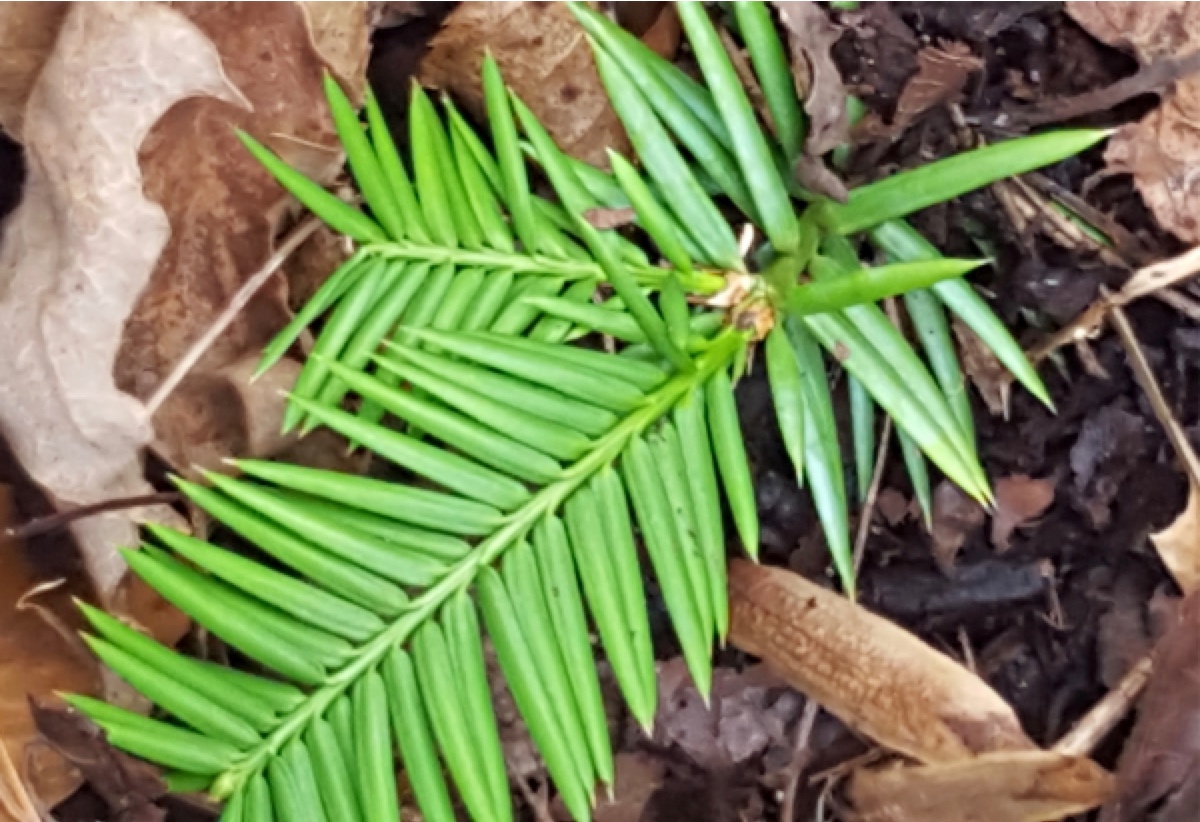
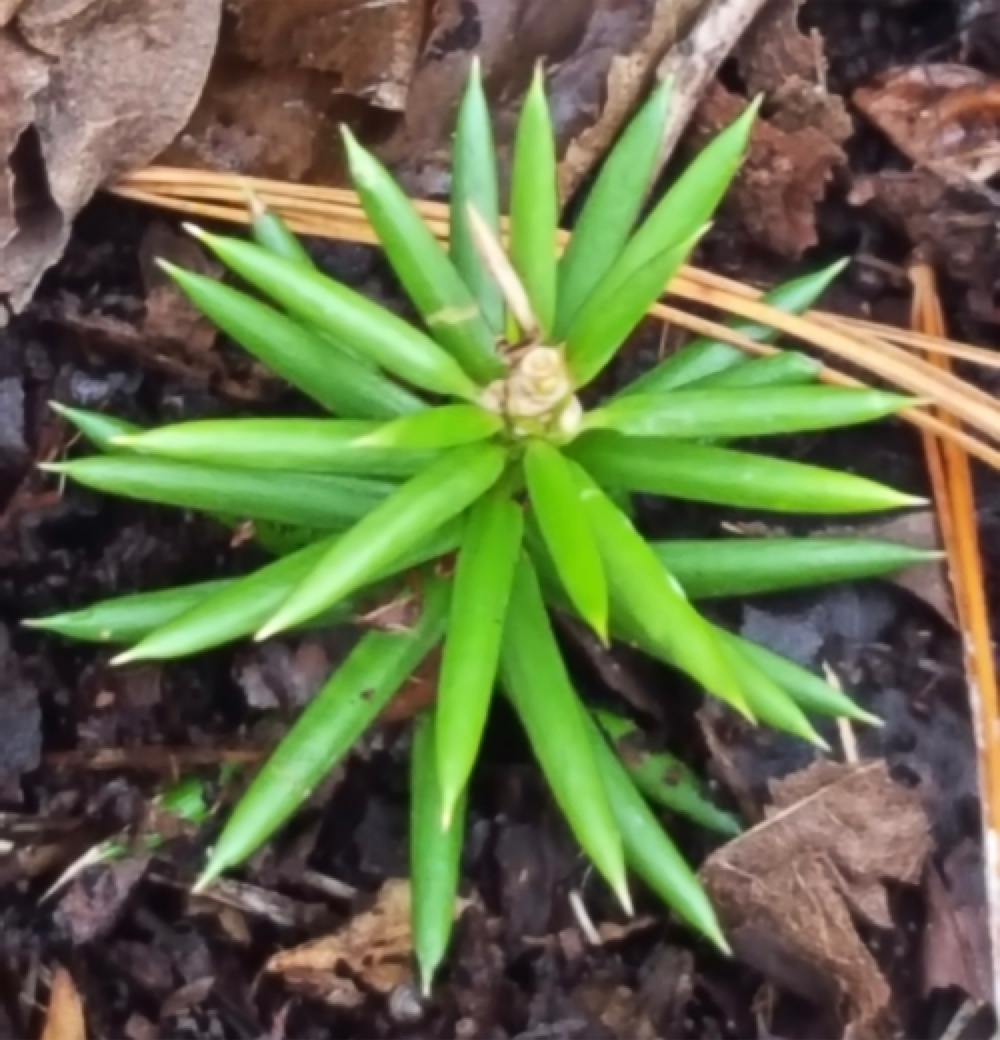
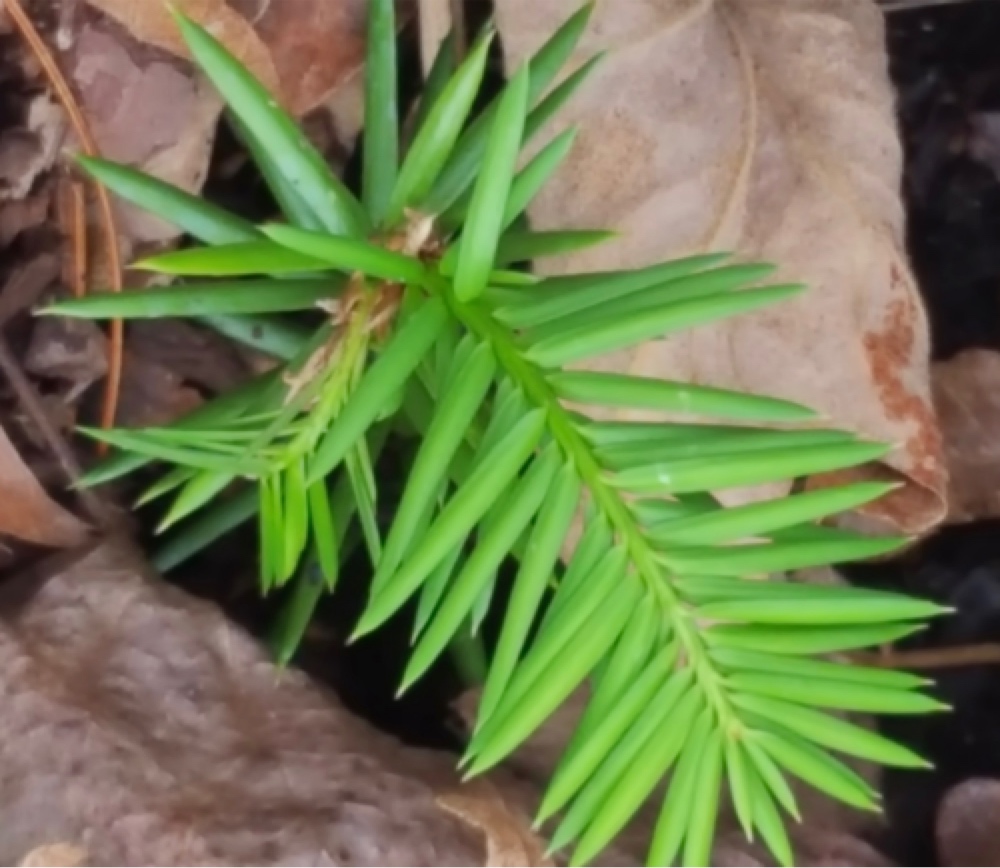
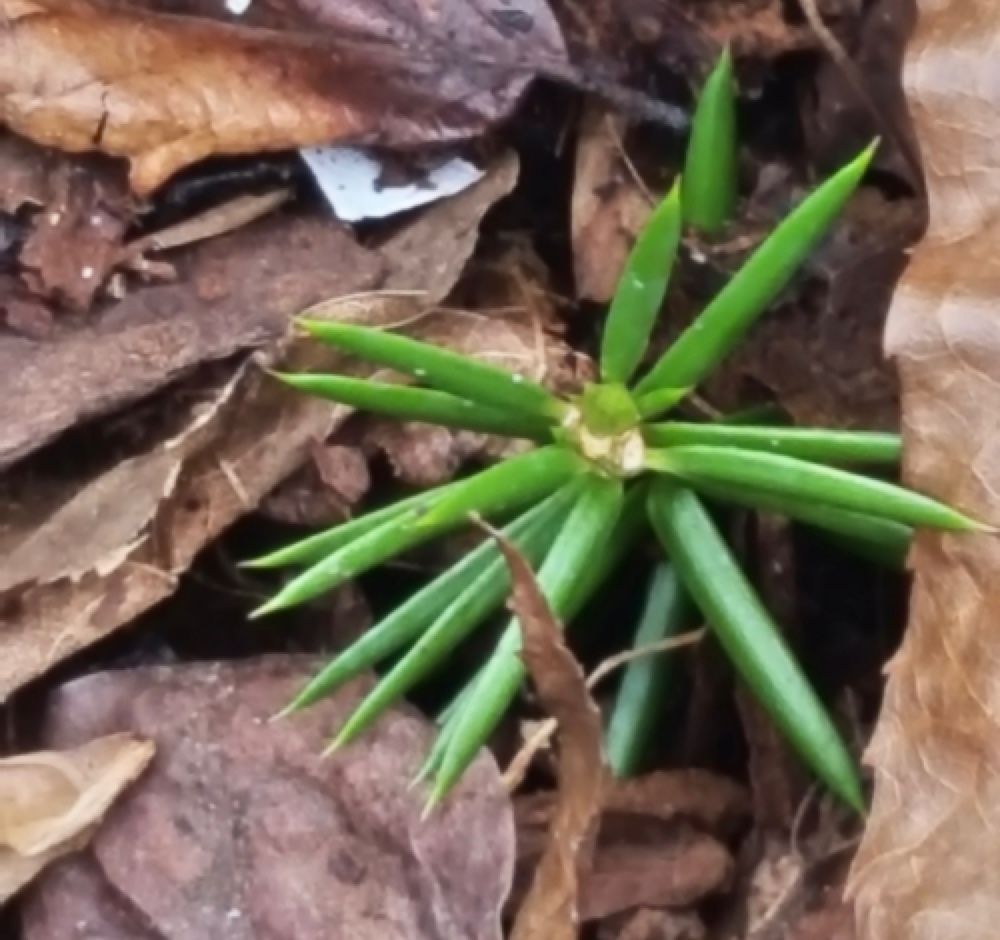
ABOVE: Photos 1 and 3 show dominant lateral growth still; not vertical leader growth. But I have ongoing experiments rooting true apical basal cuttings from other trees — and they also look this way for a year or so before sending up leader growth. My thought is that, rather than continuing vertical growth right away, they put on a lateral branch first to maximize light capture. Next spring/summer may tell.
• September 2023 / Clint Bancroft / Good news on the seedling from the Louisiana torreya tree
I have good news from Greasy Creek. As you know, there was only one seed from the 5 we were gifted from the Dorman torreya collection in Louisiana (November 2018 site visit). I had the good fortune, and awesome responsibility, of being the holder of that single seedling. It is doing well, still in its pot behind an impassable fence wire barrier. This year the tree has put up a basal sprout. I plan to leave it on the parent until next fall and then collect it for rooting. My sense is that it is yet too small for collection this year. This, being the rarest among our collection from various seed sources, will be dealt with very cautiously.
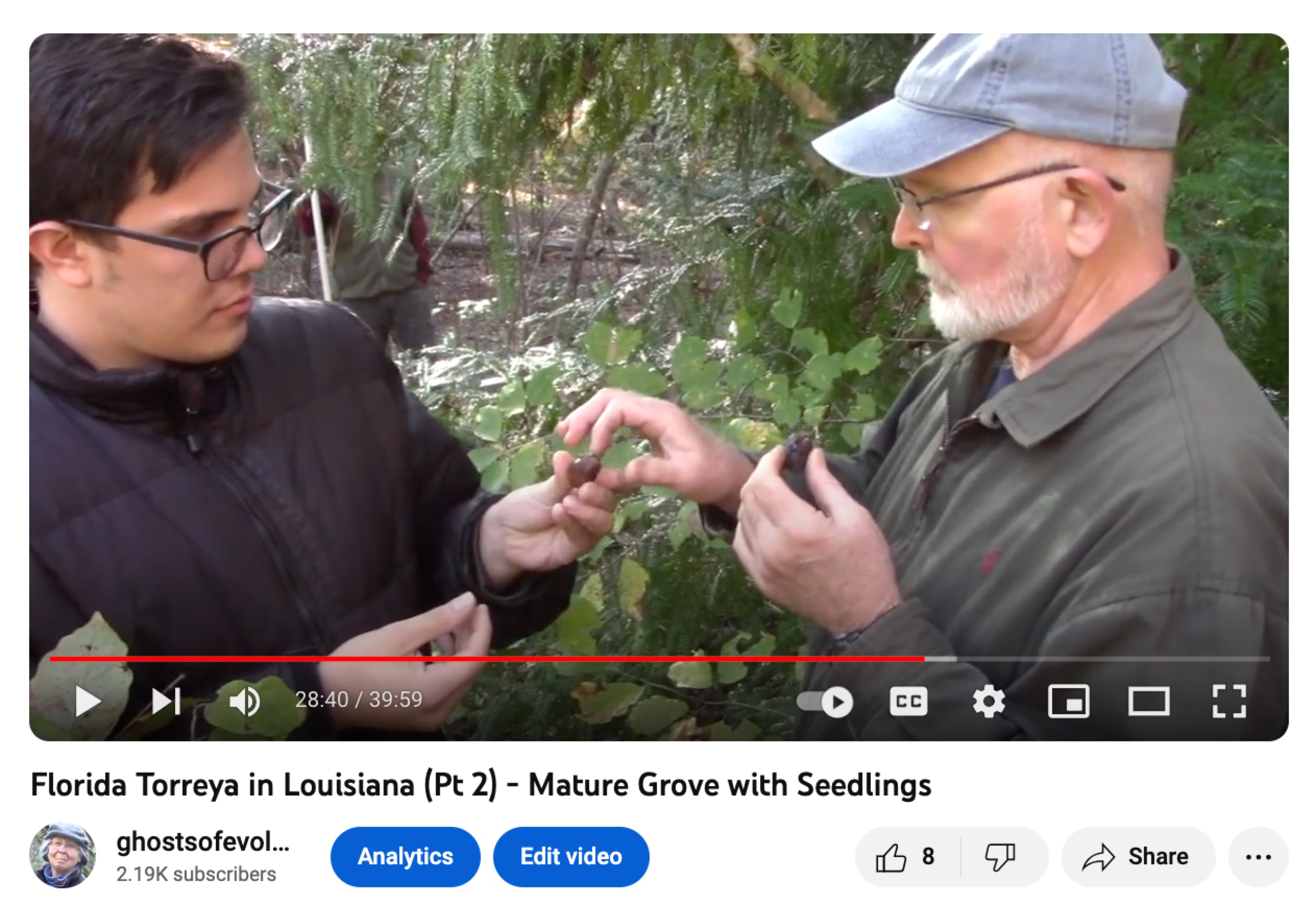
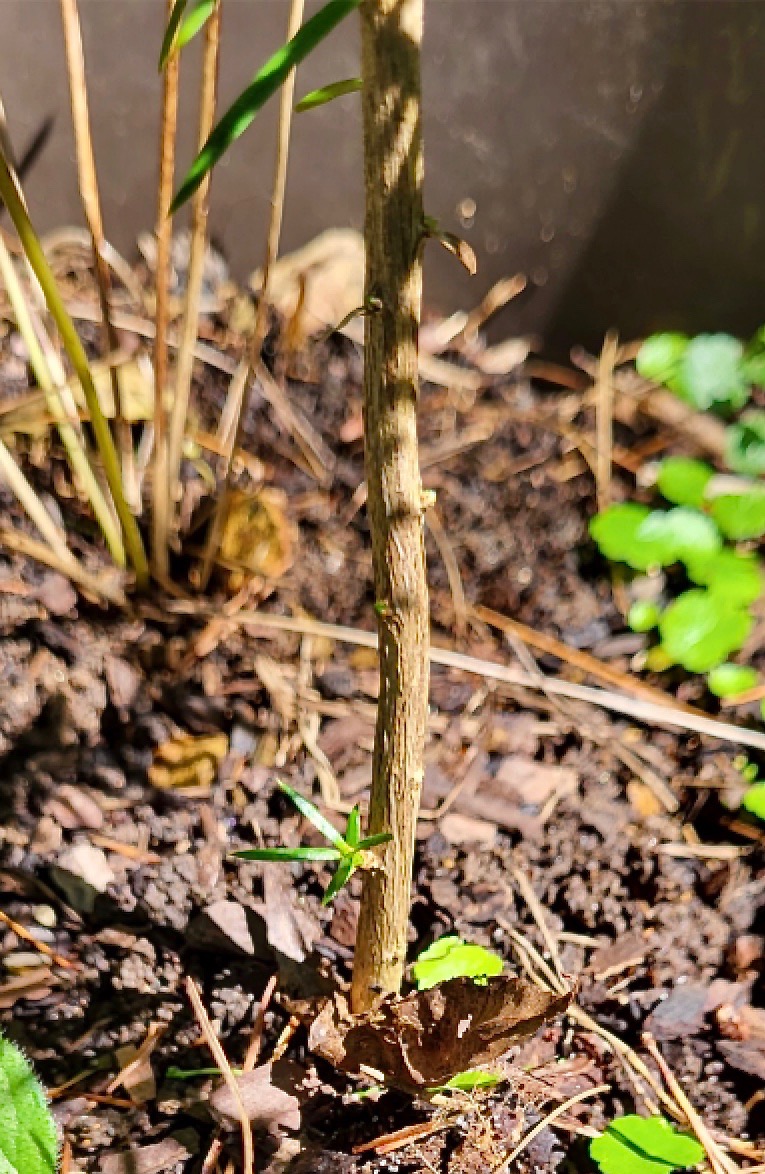
Editor's note, with above photos:
ABOVE LEFT: Clint Bancroft receives several torreya seeds produced by the tallest Florida torreya at the Caroline Dormon Nature Preserve in Louisiana, November 2018. (The tree is immediately behind Clint.)
ABOVE RIGHT: Clint took this photo nearly five years later (September 2023) of the basal sprout emerging from a young torreya growing from one of those seeds. (It takes 2 winter stratifications before torreya seeds will germinate.) Clint Bancroft is a Torreya Guardian who aims to plant the most genetically diverse population of seedlings in a wild forest setting on his property along Greasy Creek, in the Ocoee watershed of southeastern Tennessee.
• October 2023 / Clint Bancroft / A torreya grown from seed emerges with a triple stem
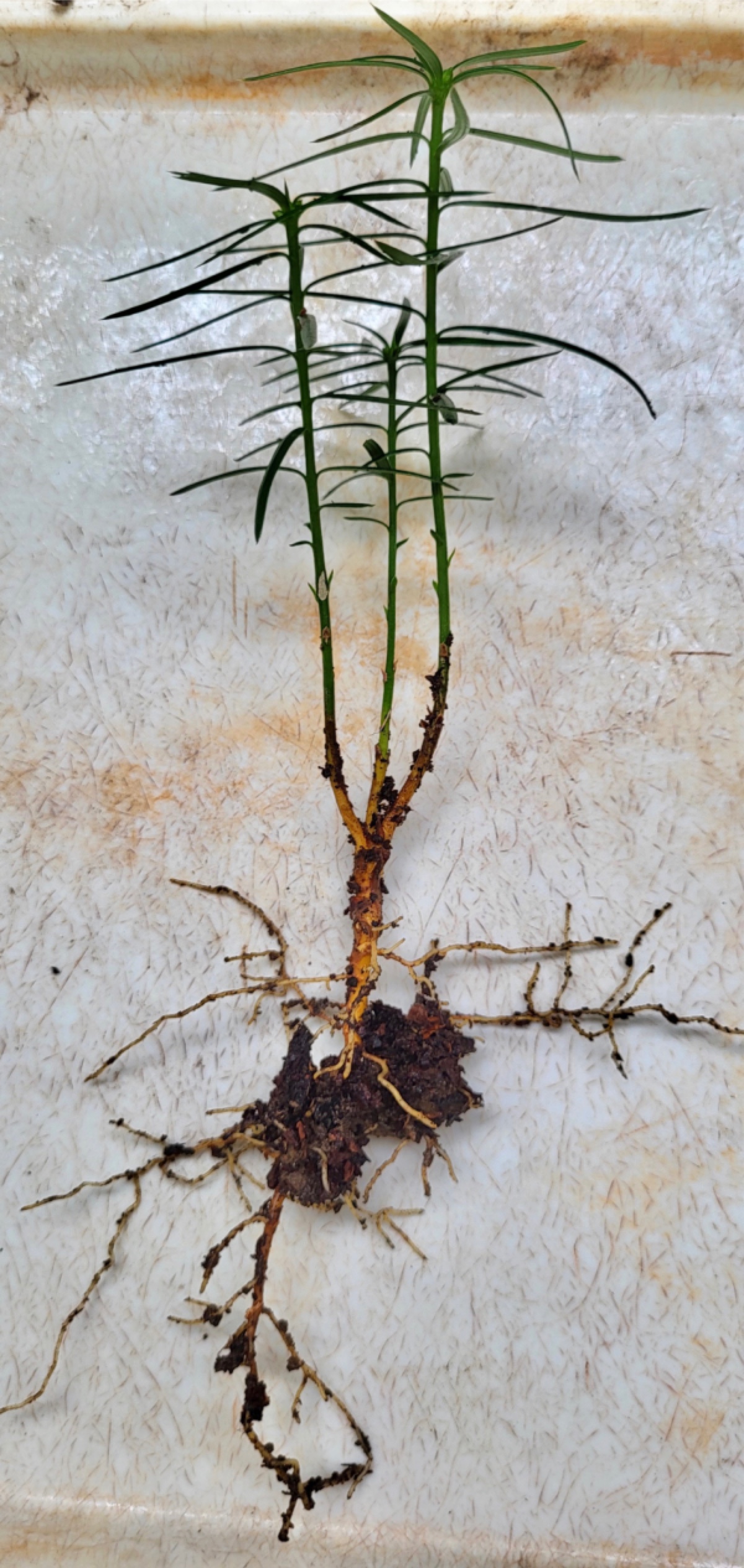
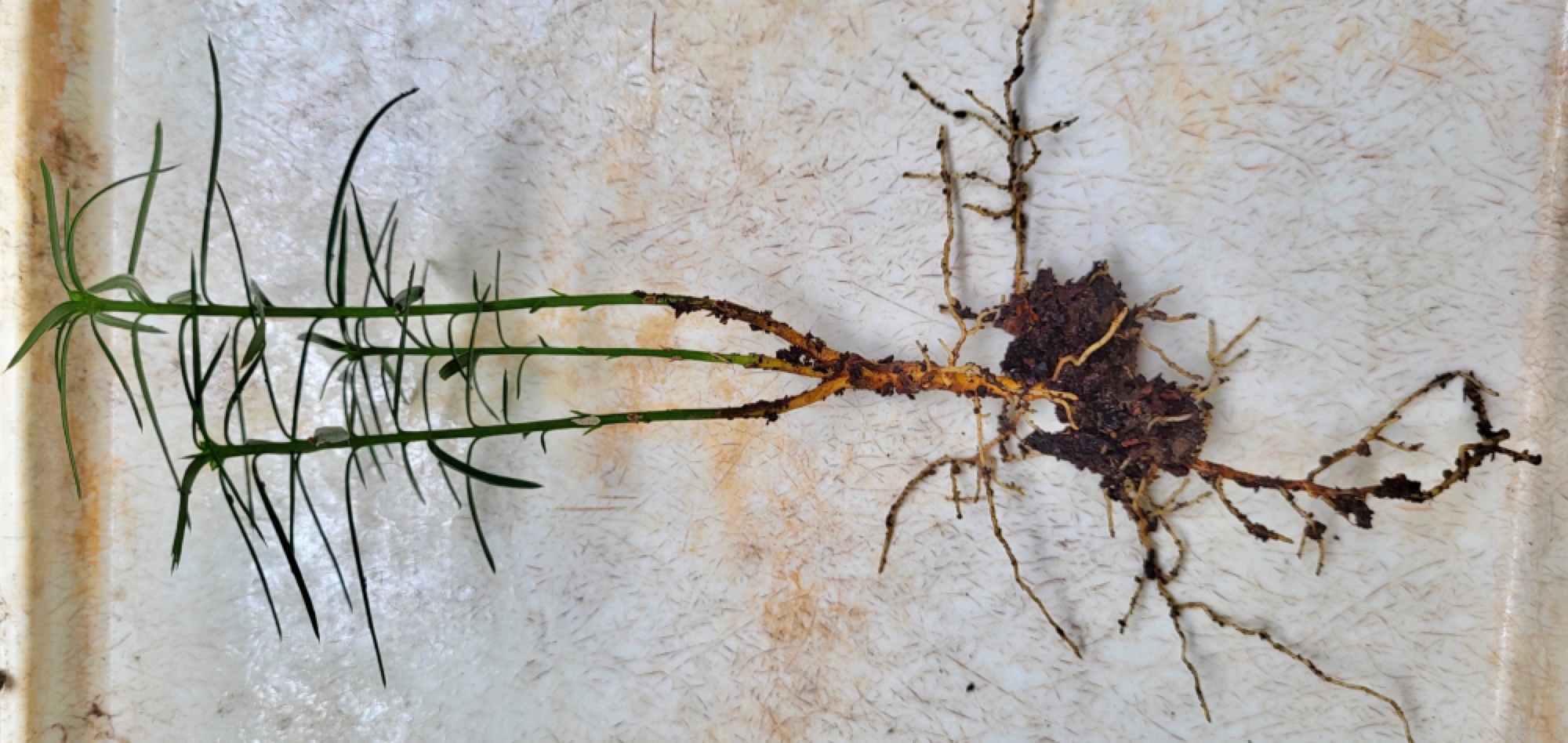
Torreya as trinity! Today as I was removing seedlings from their group container to put into individual one-gallon pots, I discovered that one had emerged from a single seed — but had three trunks! Never before has a seed sprouted with more than a single trunk. (The group of seedlings in the container all sprouted from seeds harvested Fall 2021 at Mt. Olive, North Carolina.)
• November 2024 / Clint Bancroft / A torreya grown from seed emerges with a triple stem
My single Caroline Dorman Preserve (Louisiana) tree had a basal last year! However it was still too small to risk a rooting attempt. I decided to check it again today and found that it is still too small. However, there are now 4 more new basals, which are not much smaller than the pioneer. But they are all still too small to harvest.
• January 2025 / Clint Bancroft / After the snowfall
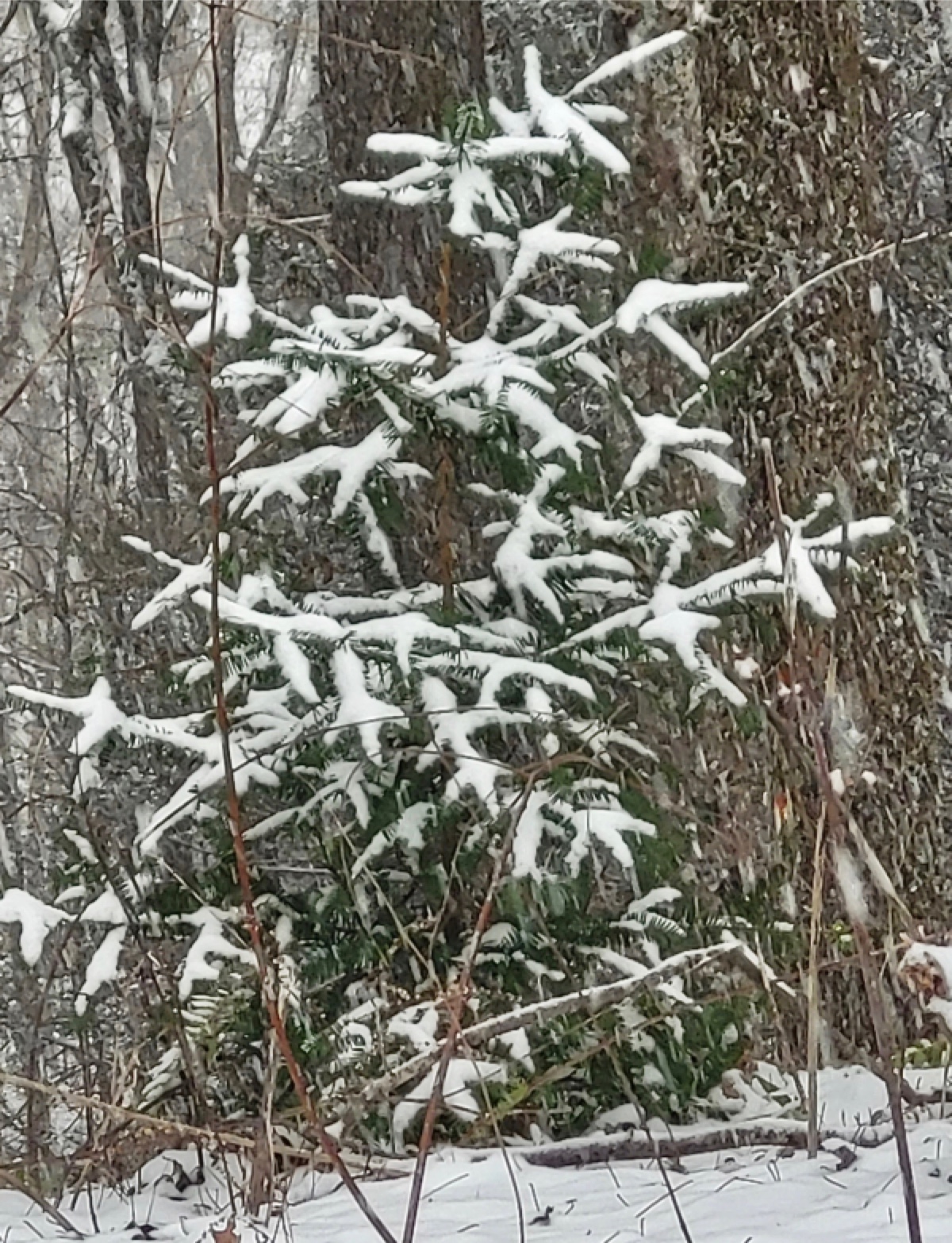 |
|
There are two separate trees like this, right after a snowfall. Both are in wire cages which don't show up well in a photo. They are planted on the forest edge, just at the top of a steep slope.
The site is up at the old motel part of the property. They get morning sun and are mostly shaded in the afternoon but still have good light.
These trees I purchased by driving to Mail Order Natives in Lee, Florida. They outperform trees from all other sources. They have grown dramatically since planting probably 3 years ago now.
This growth is characteristic of trees from Mail Order Natives in my experience. It has to be genetics. Clinton and Highlands NC trees live and grow, but nowhere near this rate. One of the trees had 13 inches of vertical growth in one year.
I planted them both in an entourage of Christmas ferns.
|
• February 2025 / Clint Bancroft / Squirrels planted another torreya!
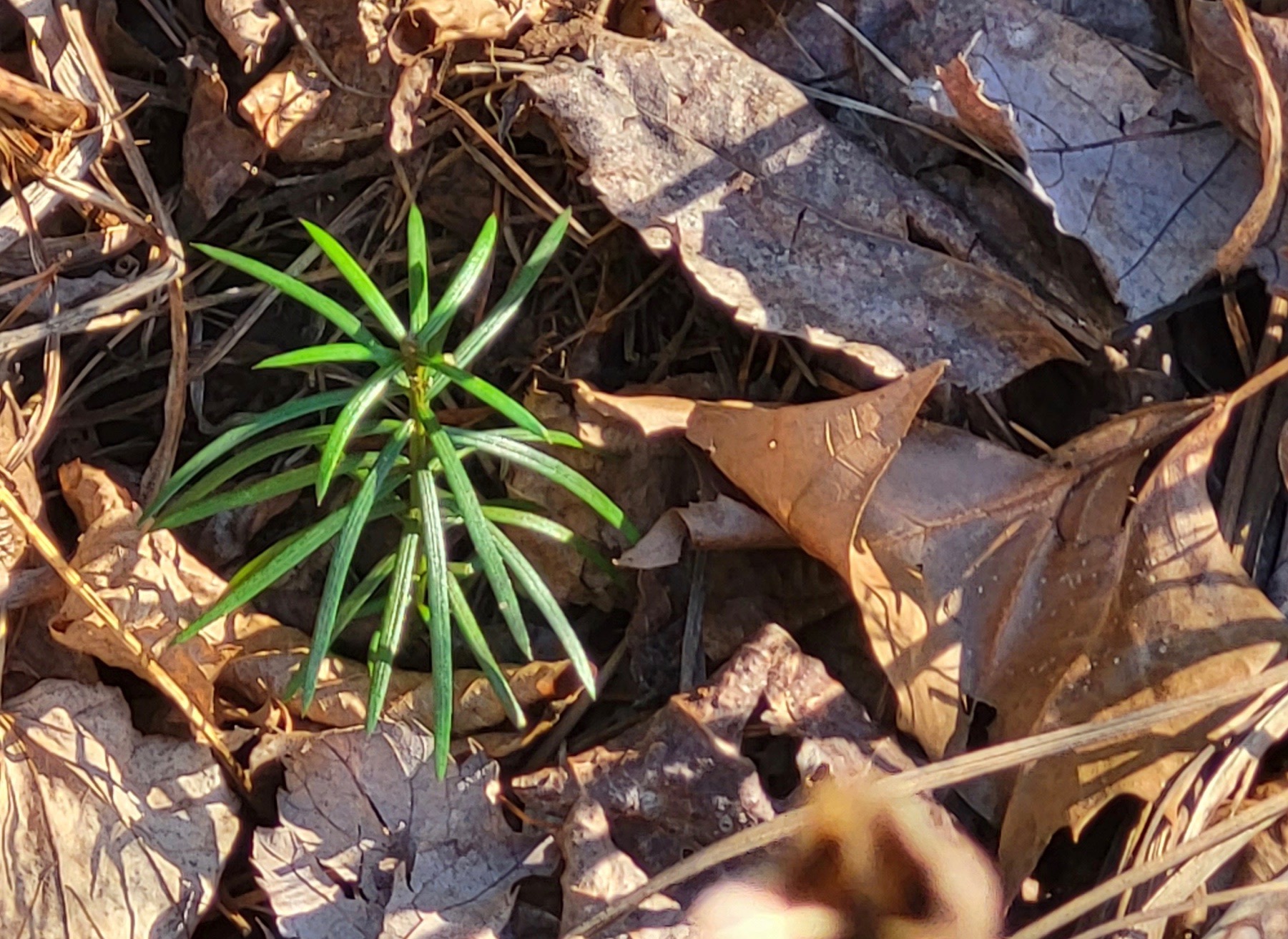 |
|
Connie Barlow writes: I received an email today from Clint, with a photo of a now-third example of a squirrel being a skilled planter of a torreya seed. Somehow the squirrel was able to steal this seed from a very protected winter stratification site, and then securely planted it for future eating, as squirrels are skilled at doing.
Clint sent me the photo, with this text:
"This little guy was sitting right there in a bed of irises. How did he get there?? Obviously it had to be a squirrel, but how did he get the seed?"
See the previous 2 examples of squirrels assisting Clint in the October and December 2019 entry.
|
• March 2025 / Clint Bancroft / Destruction by voles
Connie Barlow writes: Clint sent me an email in which he reported more destruction by voles of young torreyas that had been planted in a distant part of his forest he calls the Torreya Bowl (as it is the bowl-like low area surounded by curving slopes on all but one side). Plantings amidst downed logs and large branches might have been the reason the vole population took such a toll. He now calls it the Vole Bowl, and he dug up the remaining unique genotype (seedling born from Medford OR 2016 seeds). Clint wrote:
"The seedling is now heavily protected by wire mesh on top, bottom, and sides and is now in my propagation area. The good news is that it is healthy, came out of the ground easily, and with a nice clump of soil which did not fall off the roots. Also, it has two nice basal sprouts so that eventually I can cut and root those and then be able to replace the two other Medford speciments eaten by voles."
• September 2025 / Clint Bancroft / Photo updates on 3 torreyas
 |
 |
|
Clint writes:
LEFT: This is the Torreya I thought was dead, but which sprouted a new vertical (left of the dead original). Provenance is unknown since it was only tagged as "Bowl rescue" (from the forested site called Torreya Bowl). Maybe a vole attack survivor?
MIDDLE: This is the second squirrel-planted Torreya up by the propagation trailer, both in a bed of irises. It is about 4 feet from the one I reported in February.
|
_________________________
The Clinton NC rescued torreya - 6 years later
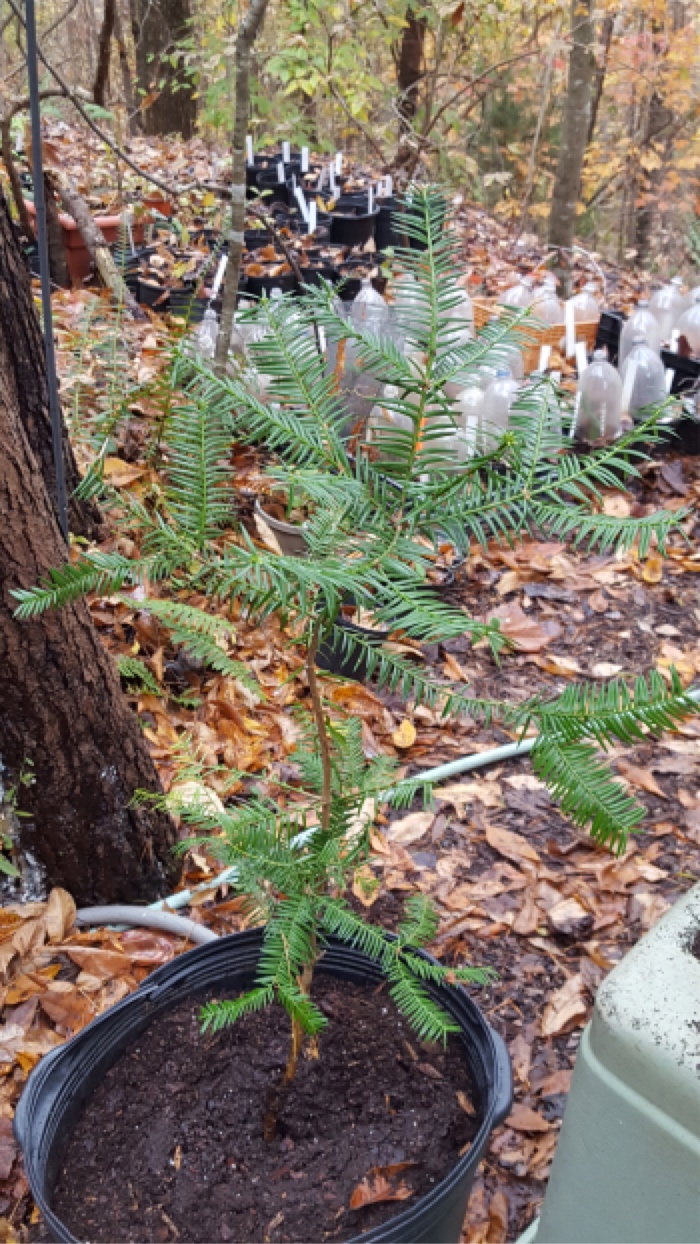


ABOVE LEFT: Clint Bancroft took this photo in November 2019 of a young torreya he had dug up at the request of a landowner in North Carolina. As documented on the Clinton NC Torreya page, he had visited the tall, mature Florida torreya tree at the home of Mrs. Kennedy in Clinton to collect seeds that month. She gave Clint permission to collect any seedlings he found, which amounted to 10 first- or second-year seedlings directly under the tree. She also asked him to remove this older torreya because it was challenging the Camellia it had grown up under (and whose proximity had thus far saved it from the lawnmower). NOW COMPARE THAT PHOTO TO THE NEXT.
ABOVE CENTER: In September 2025, Clint photographed how this same tree looked where he had planted it at his TN home six years earlier. What is remarkable is not how little the torreya has grown in six years, but that it survived at all. Torreya has a long taproot, and this may well be the biggest torreya that has ever survived a transplanting by a Torreya Guardian.
ABOVE RIGHT: A top-down view of the Clinton transplant shows healthy lateral branch growth, but an unwillingness to put much energy into growing the main stem any taller. Instead, as shown in the below set of photos, the new growth is happening at the base.



ABOVE: September 2025 photos of the basal growth of the torreya rescued from the Camellia in Clinton NC. Look carefully to see the two upward growing basal stems — either of which could become the new main stem. However, one wonders if the injured taproot is the reason this torreya is acting more like a shrub than a wannabe Christmas tree.
Return to HOME PAGE